September 10, 2017
Martha O'Kennon
A whole week of cool autumn temperatures. Just as I was inspired to go outside and breathe the fresh air, the wasps on the goldenrod became more somnolent. Sometimes I will go out in the morning and find a few wasps, locust borers, and another order or two of other insect, less likely a spider now, all sound asleep right next to each other.
Here are the pink Japanese anemones, fighting their way through many weeds and just as beautiful as ever. Although the purple asters started blooming in the back yard a couple of weeks ago, the pink ones are just opening up. I like to look down through the buds towards the pond with purple asters almost fallen into the water. I don't know how many more lily flowers we have in store (they DON'T like cool weather, even if I do), but I'll be glad to see them. Just in case you were wondering, they are extremely hardy and have come up each year since I planted them in 2006 - 2008.)
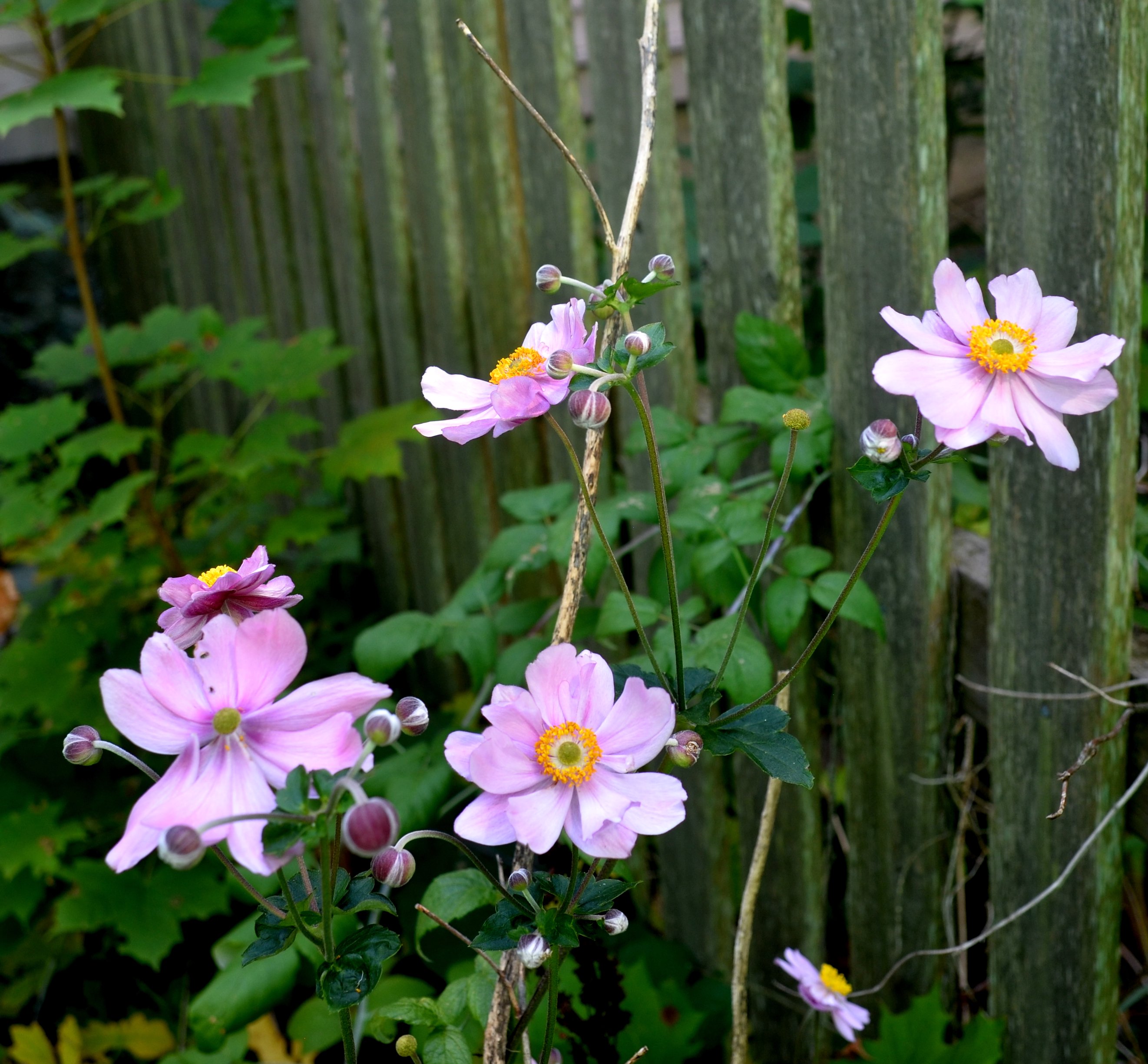
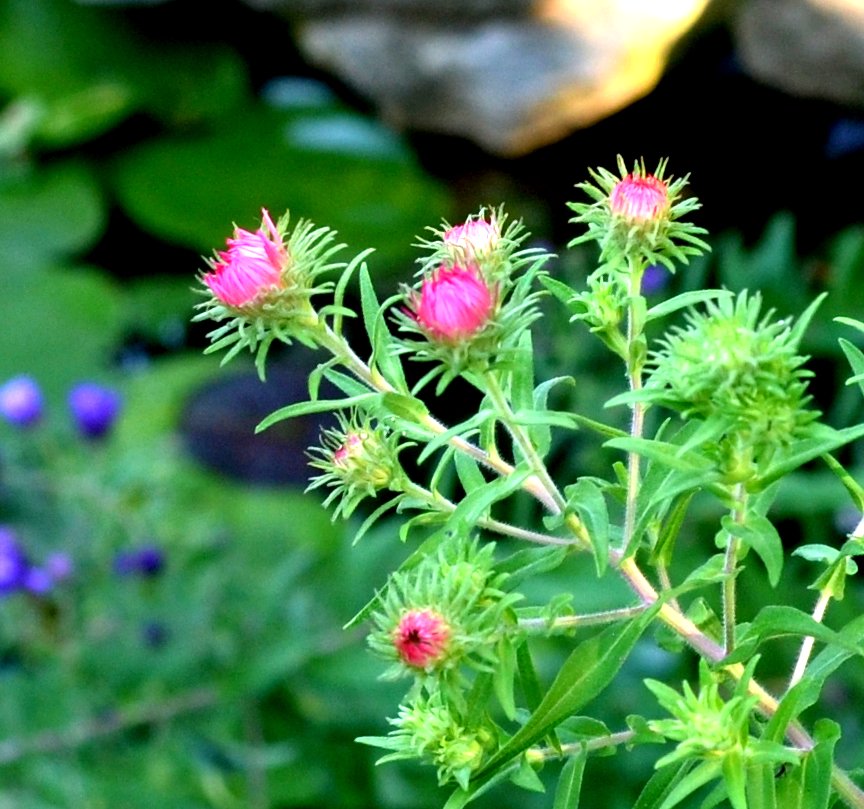
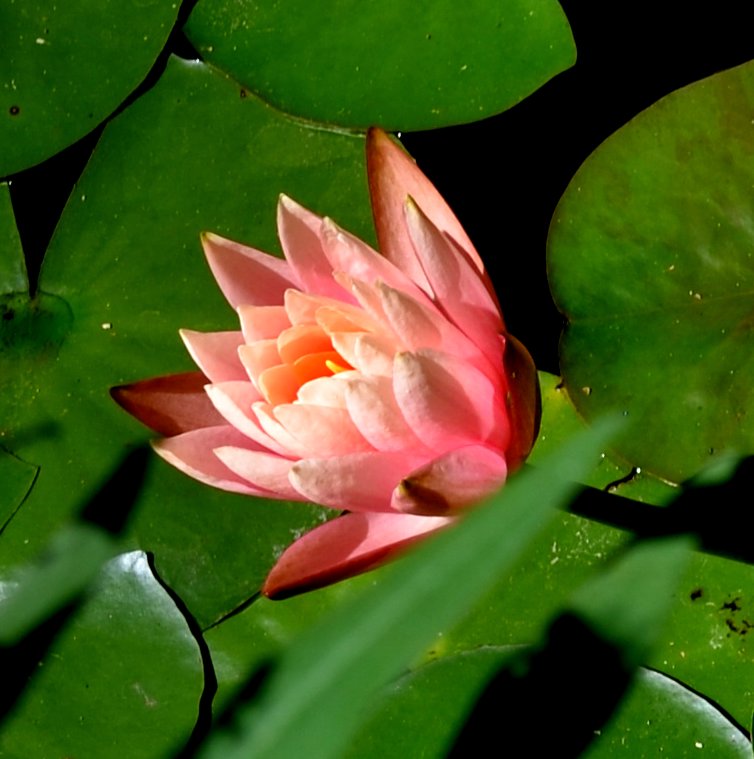
Remember that there is information in the name of the file for each image. You can see it by mousing over the image - look at the lower left of the screen. Or you can click on the image to get to the (usually) larger image. Then the info is displayed in the address line above. Sometimes the second click will actually display a different view of the original image.
I didn't see many ants this week, probably because I was out in the goldenrods, but the aphids have taken hold in a sickly pot of yellow flowers. When I enlarge the picture, they seem to be the red ones, but then I was shooting into the light. They obviously don't know about their new neighbor, a red Asian lady beetle. I wonder how the ladybug knows they are there. It could be a combination of smells: the aphids themselves probably have a slight odor, but I'll bet the dying plant sends out some kind of distress call. There are always a few barklouses - this week two new ones.
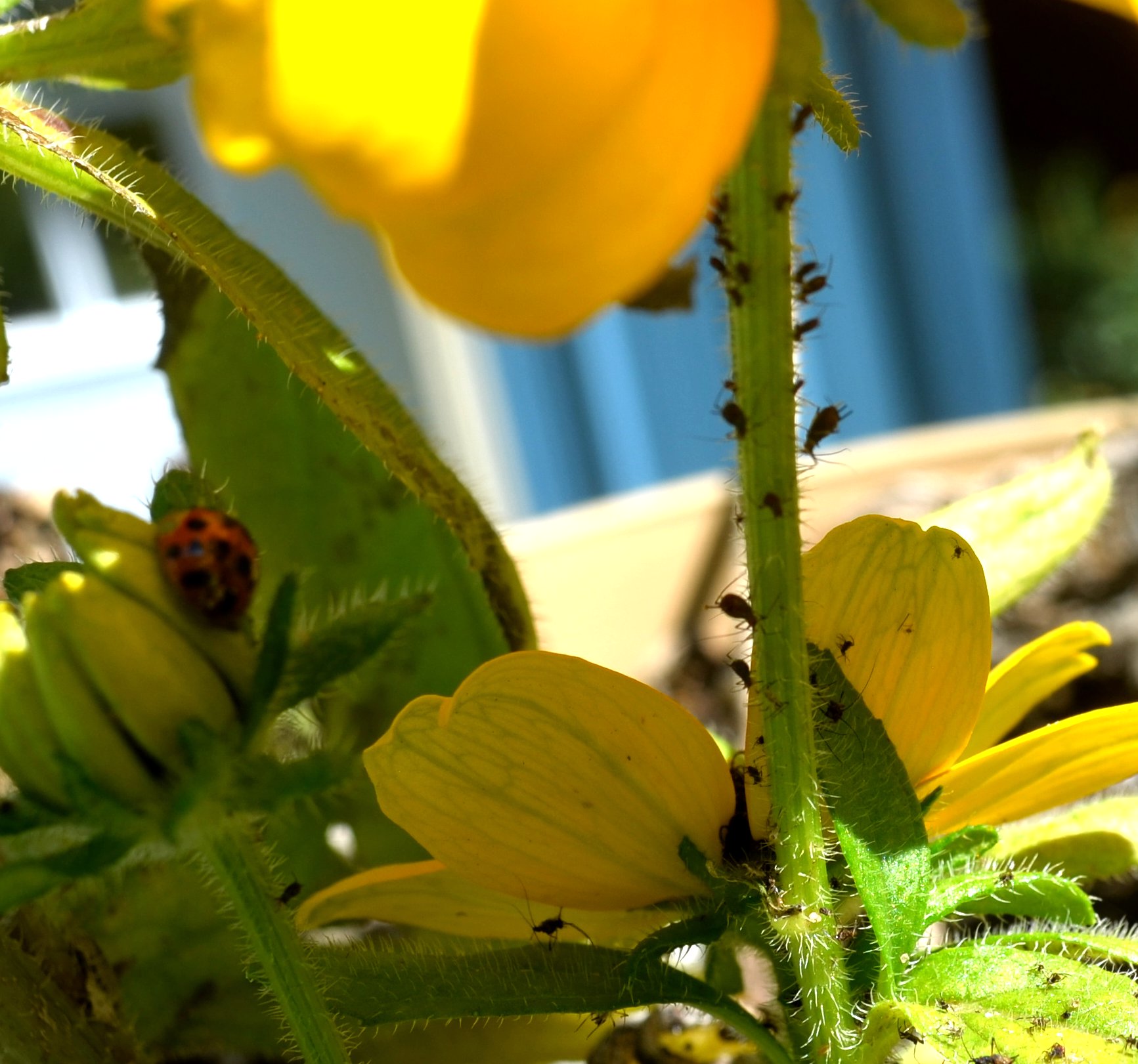
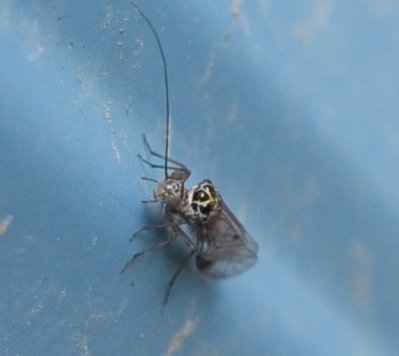
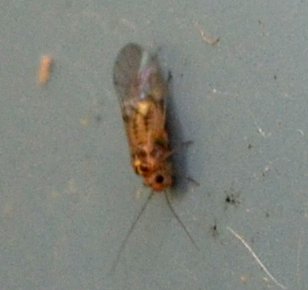
The bees were out in force, from about 3/8 inch and up. They come in all sizes up to "REAL" bumblebees. Here is a smallish bumble bee, then probably Andrena aliciae, even though Bugguide's map only shows it in Illinois and Indiana. (Usually when there is such a geographically close range, it can be found here too.) The next one resembles another of the Andrena genus - Andrena hirticincta, the Hairy-banded Andrena.
This little one may also be Andrena, based on the pollen-filled hind leg. Sorry to be so tentative on these.
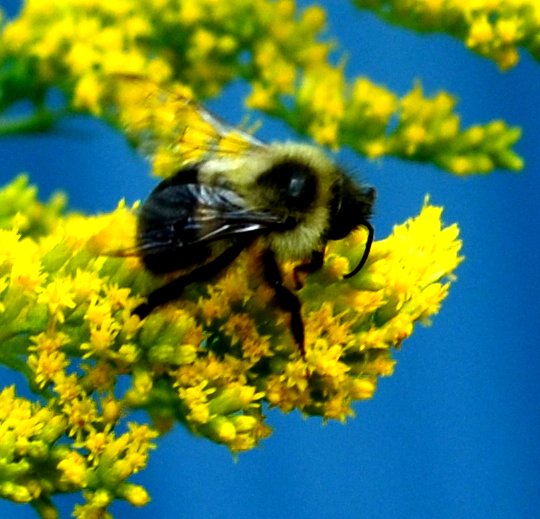

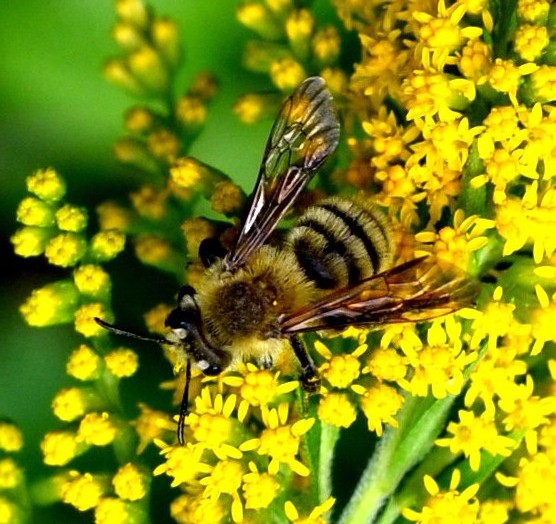
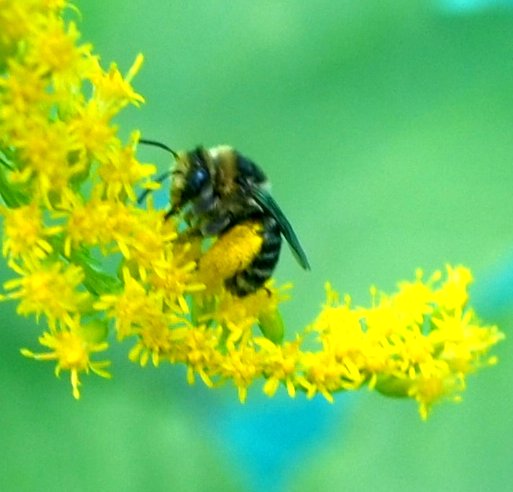
This little furry brown FLY (I don't have a face-on shot of it, else you would see some big fly eyes) is most likely Sparnopolius confusus. That's what it was last year! The next is probably Lassioglossum pilosum. The next two are up for grabs, but the last one is another of those mirror-faced bees!
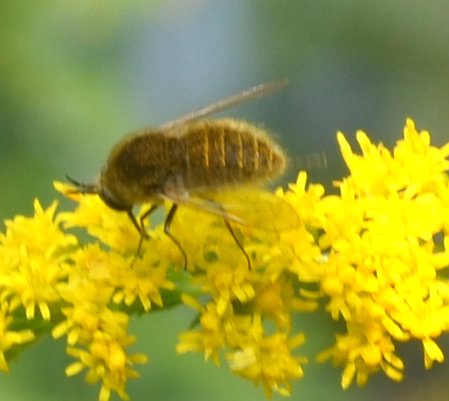
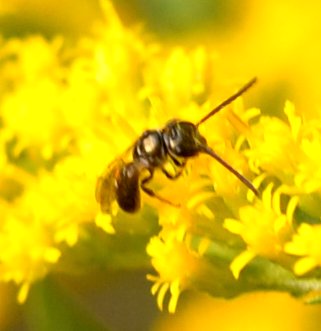
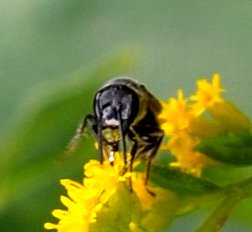
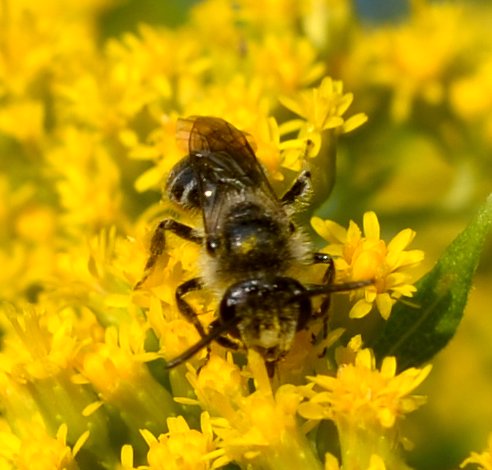
The lady-like beetles are quite common this year. Maybe that's why we have so few aphids right now! If it weren't for the "W" insignia on the collar, I would have thought this were a Polished Lady Bug, but it does have the badge.
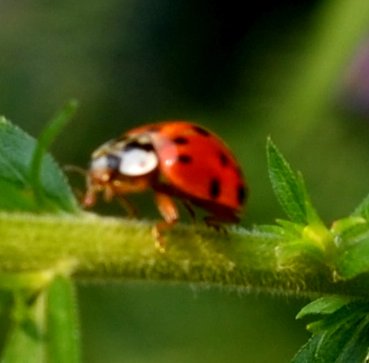
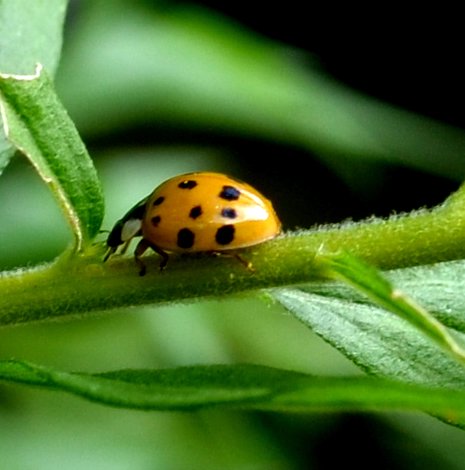
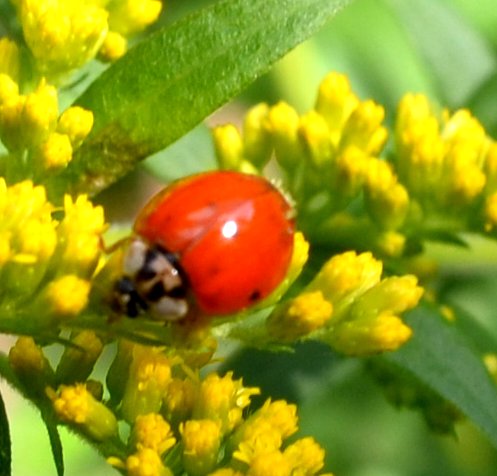
The black blister beetles seem to have packed up and left just before the big storm of guests. But the lily munchers have moved into the goldenrod. The locust borer beetles are LEGION this year, maybe dozens, on the goldenrod. Here's a couple who found love and happiness in the golden stuff.
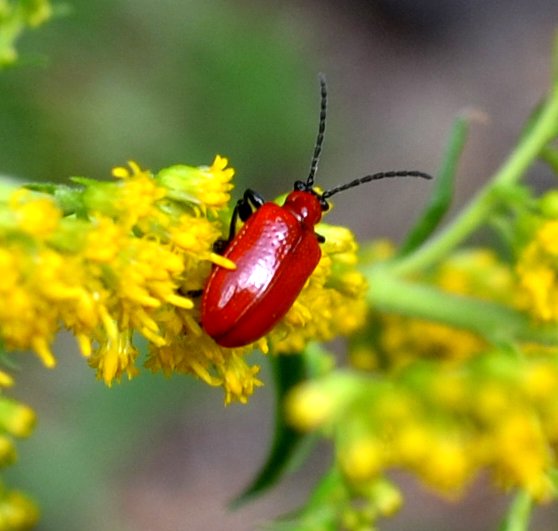
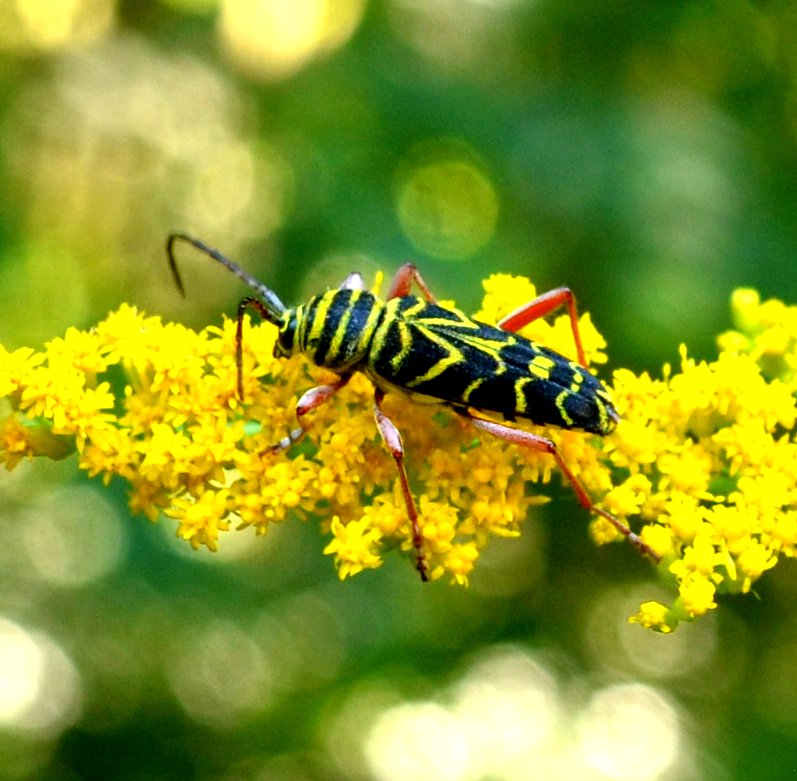
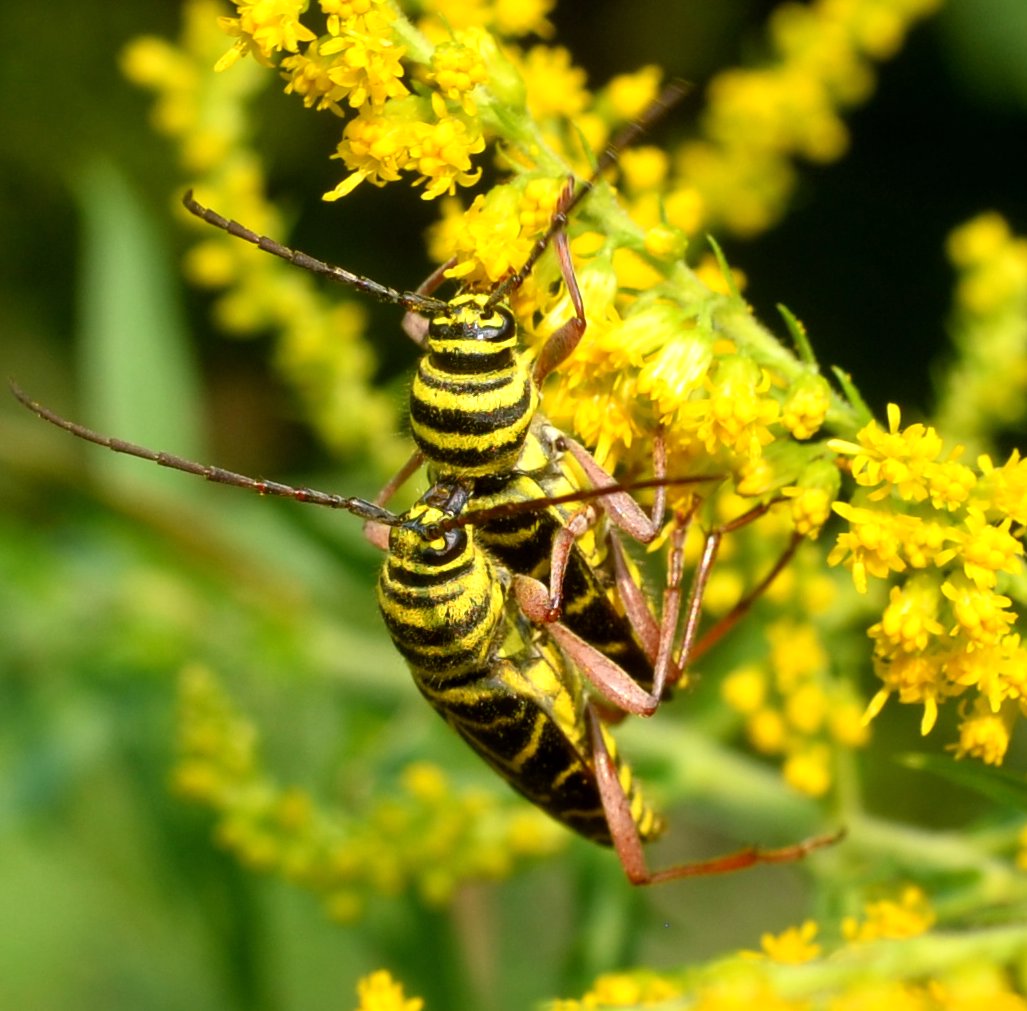
The goldenrod soldier beetle folds its wings after landing on the goldenrod. Usually it is first seen on golden flowers like Brown-eyed Susan. But this time it seems to have skipped that prize and gone straight for the goldenrod. Tnanahe Rhubarb weevil seems to have changed its signature banana skin coloration, but it still looks shapewise like our old favorite.
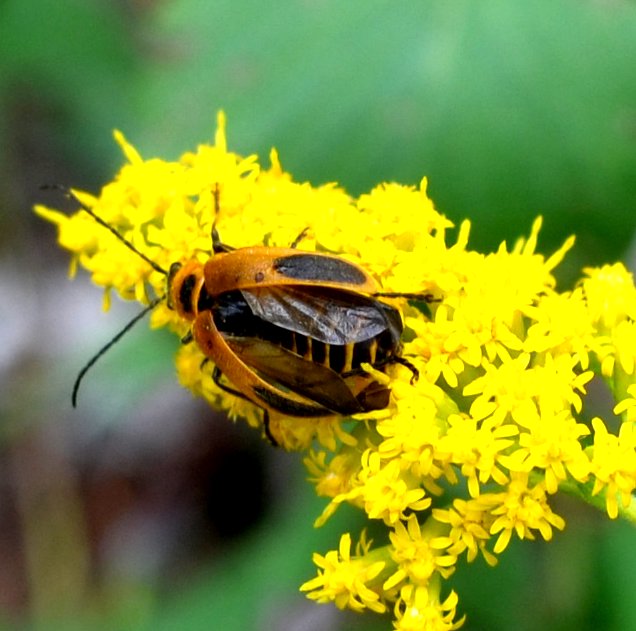
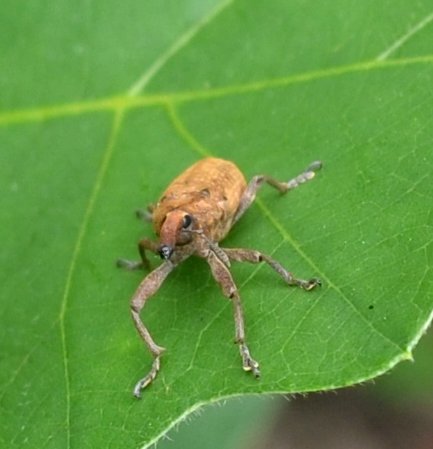
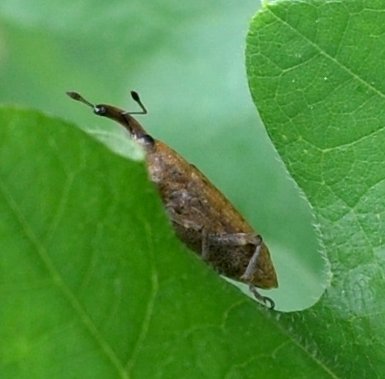
My fascination with ambush bugs goes on. Apparently there are only two species in Michigan and I think I have both right now. They are amazing, if for no other reason than that they are hardly more than 3 mm long. It makes me think of those water bears, minute creatures with all the requisites for being a critter.
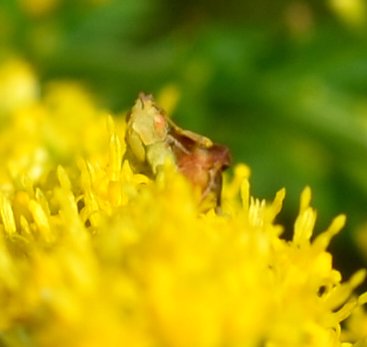


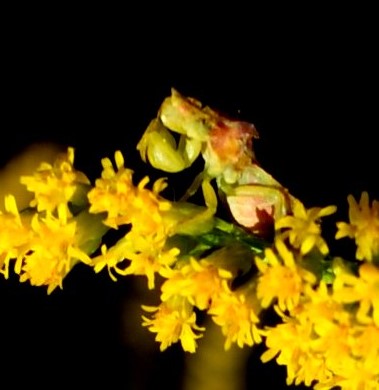
Here are two pictures with two ambushers per picture. Hint: The smaller of each pair is the male. (I don't know actually that they are a couple, but I'm trying that as a hypothesis until I can get a better grasp on the differences in the two species.)

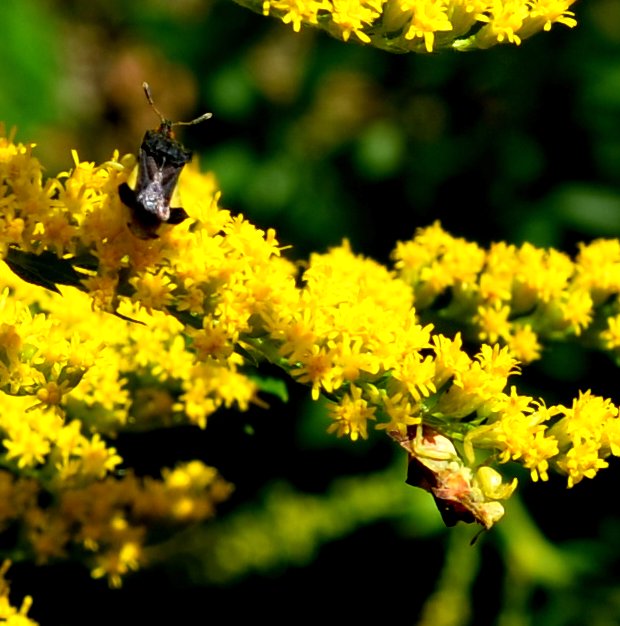
Leafhoppers! How I love ya, How I love ya, My dear leafhoppers. I wonder which family of insects is the most branched evolutionarily. The leafhoppers certainly have a place in the Guiness Book. First, some of the red on white ones that look white until you really zoom in on them. The third one is either a real pattern, or I moved the camera as I shot it.

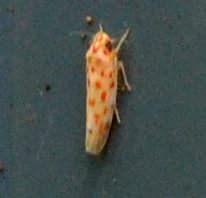
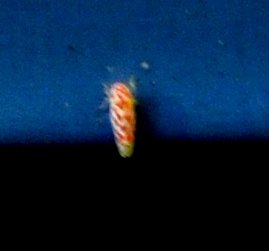
Here's our favorite candy-striper, and of course our favorite kid-grown-up, Coelidia olitoria. And here's one that's new for this year, though we have always seen lots of them, the so-called Japanese Maple leafhopper. Imagine my disappointment at seeing so few species this week.
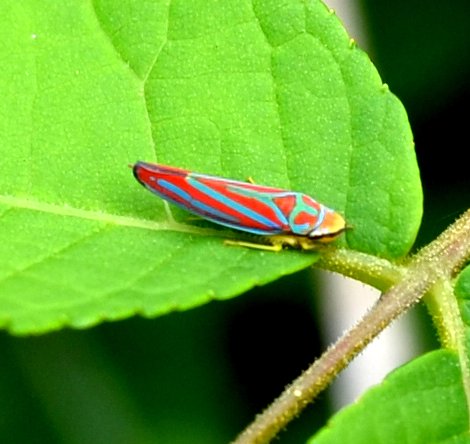

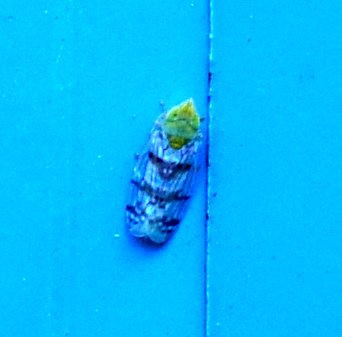
We did see one spittlebug, the one that feasts on alder. Redbud must be a great culinary treat too! And here is that stilt bug, in the back yard now.
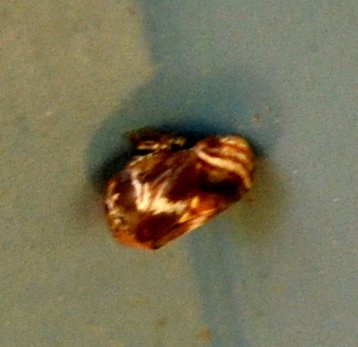
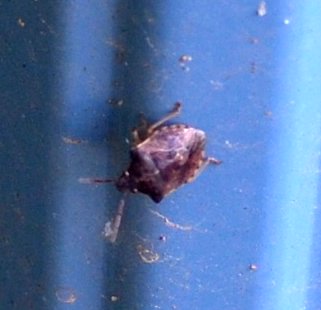
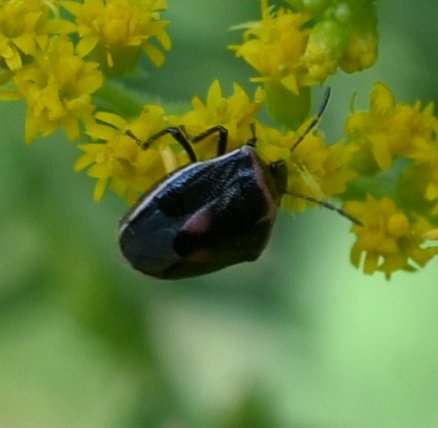
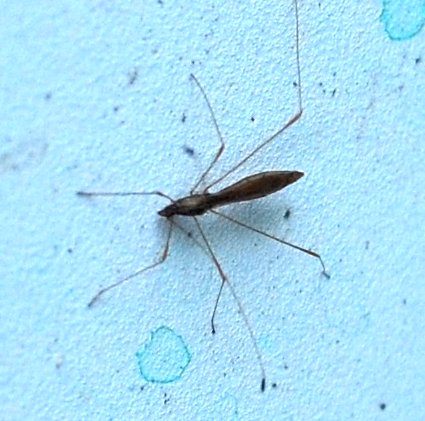
Here is that thread-legged bug, this time showing up on the 5th and the 8th of September. In the middle image, you might just be able to see some light between the two tightly clenched arms.
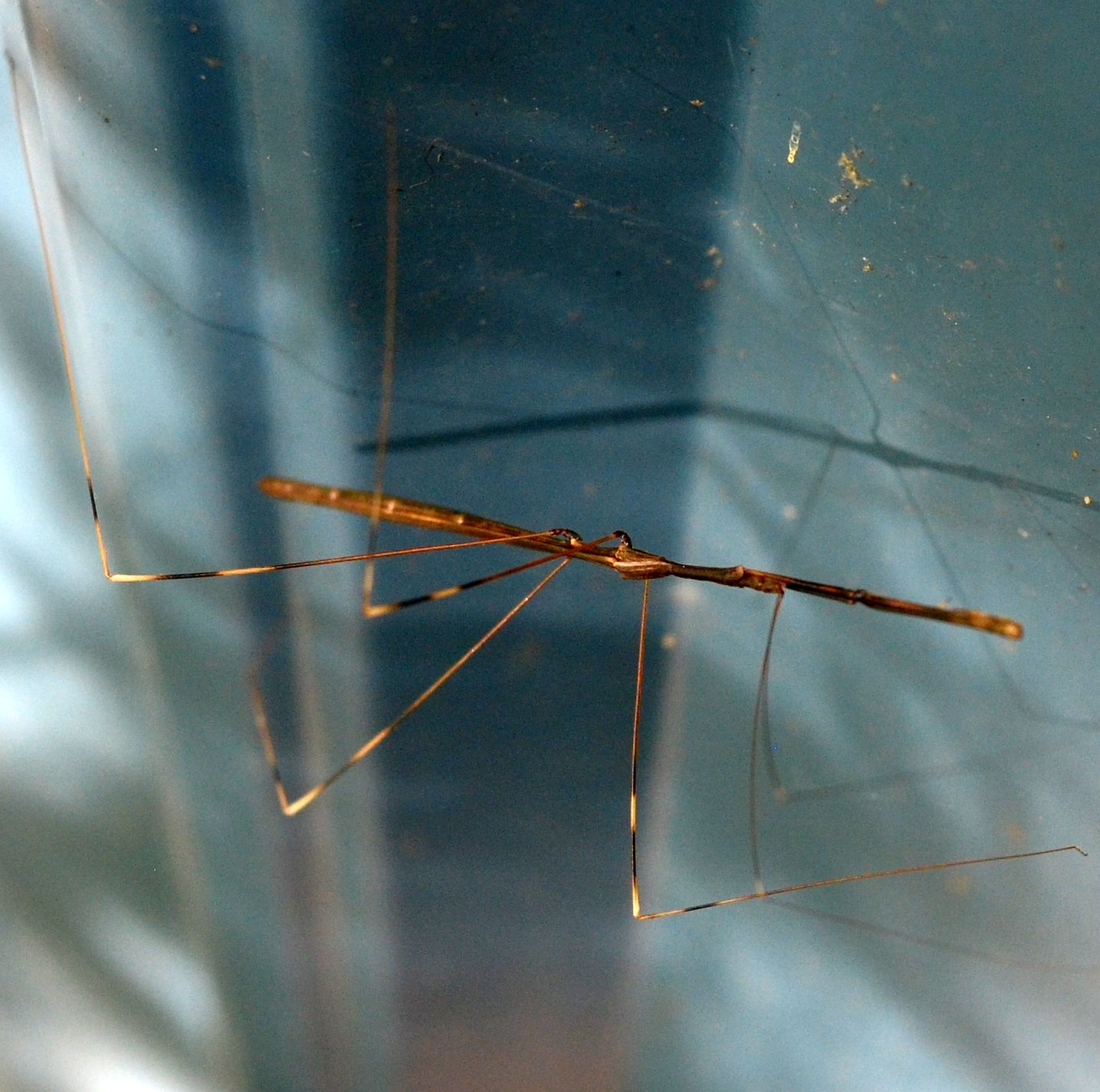
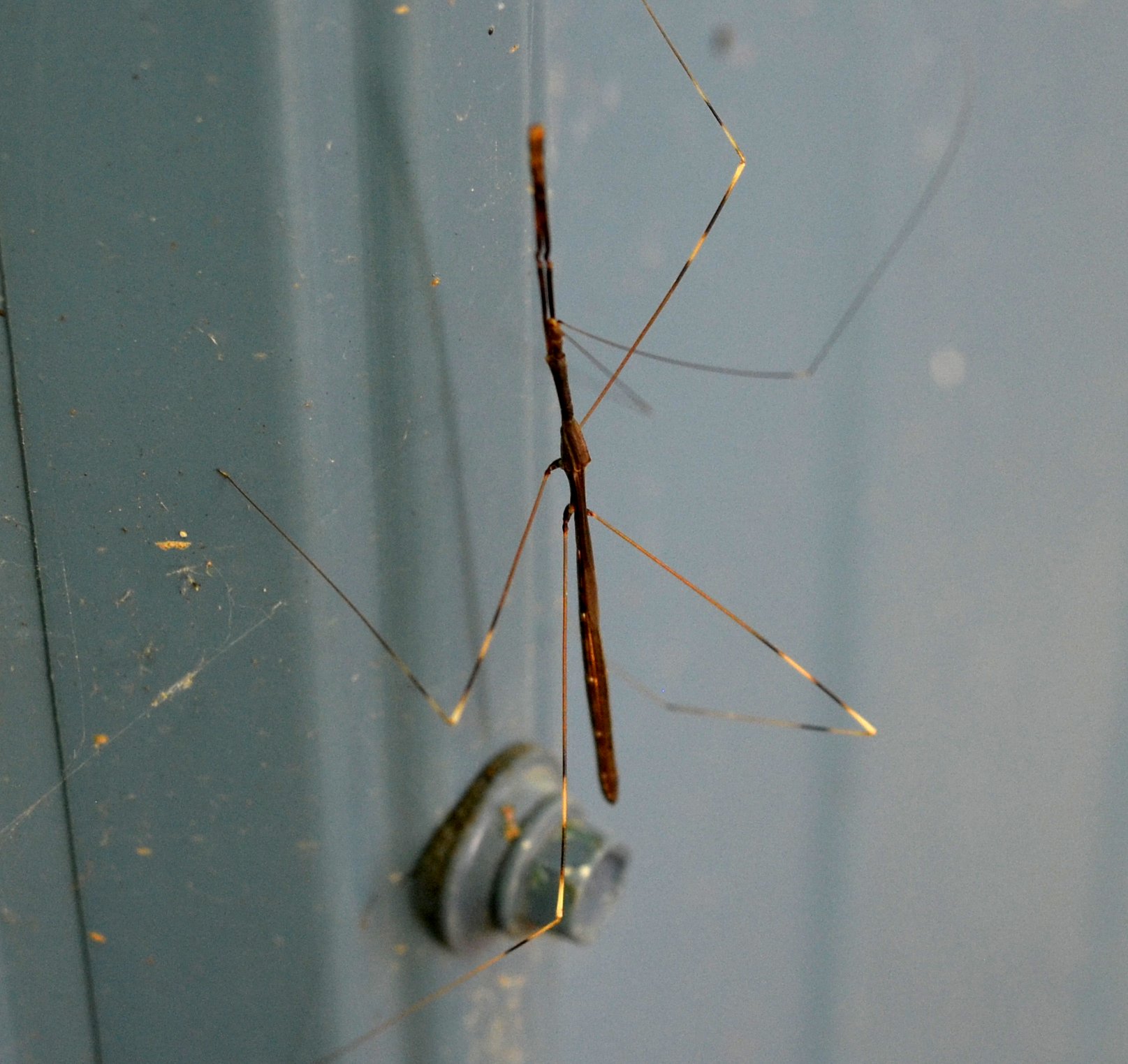
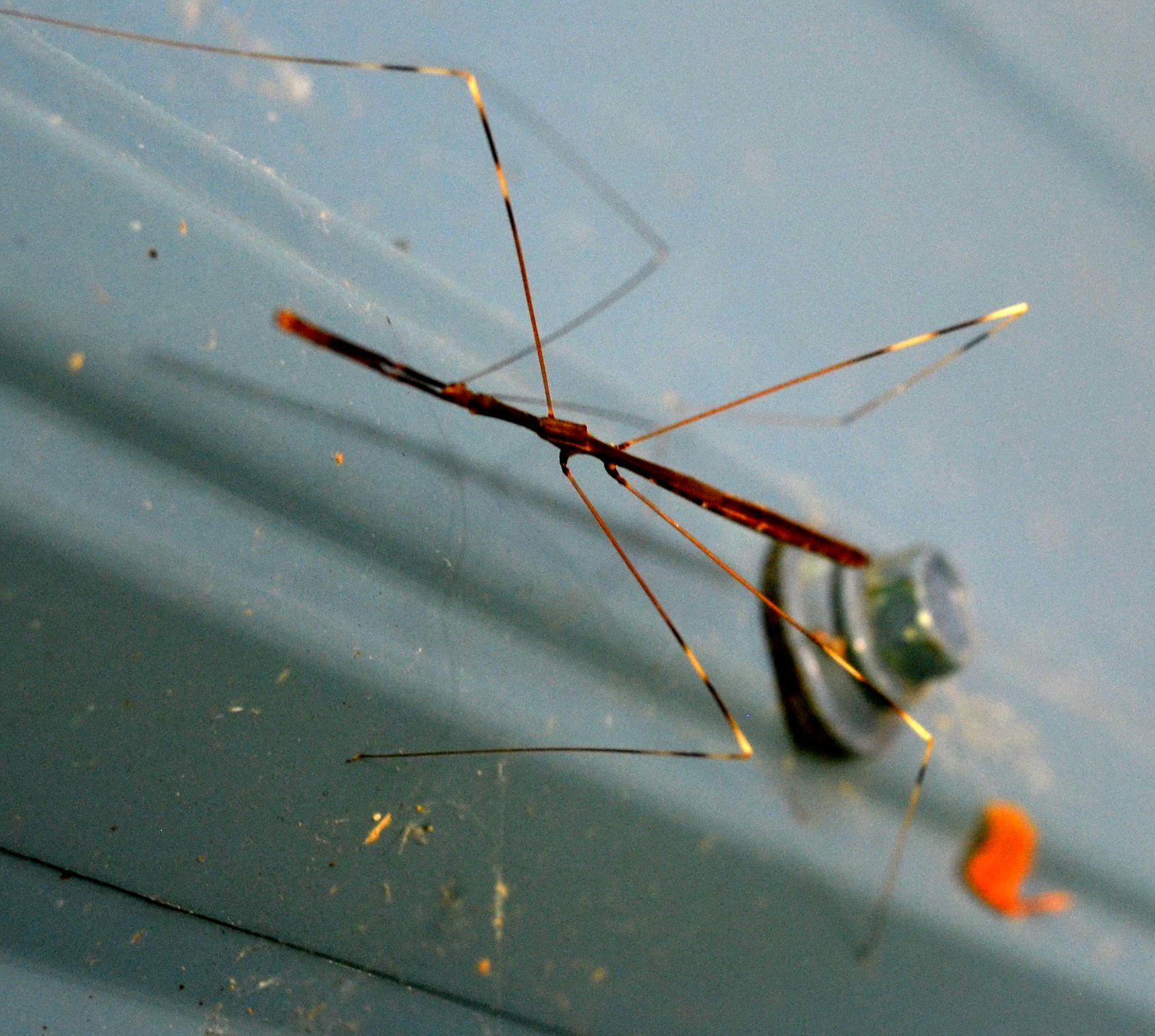
You may have noticed that I keep putting up photos of a strange little bug. It started out like this first picture, as a little black and white "bug", which sometimes I still keep calling a "spider". I decided to read up on these forms.
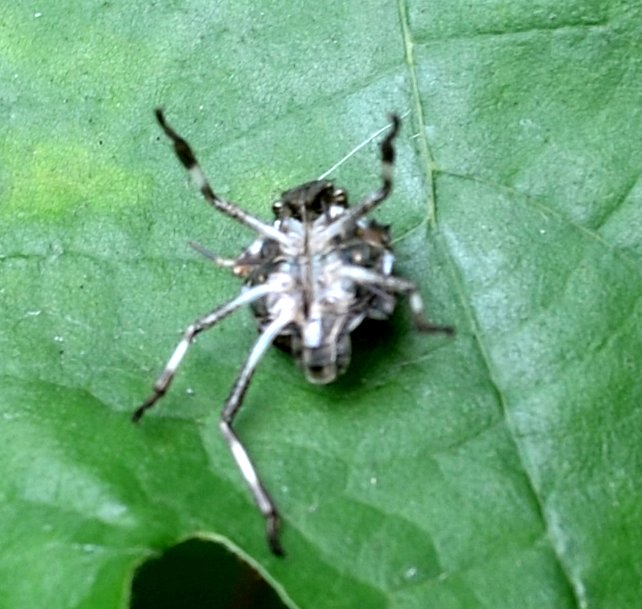
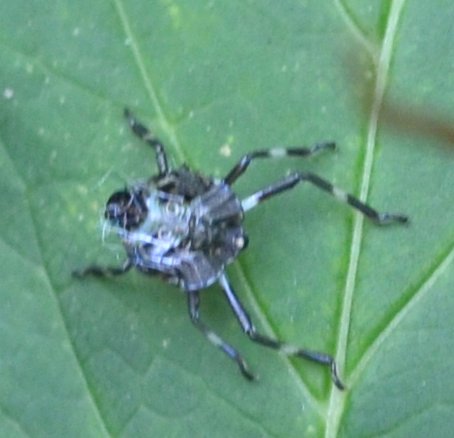
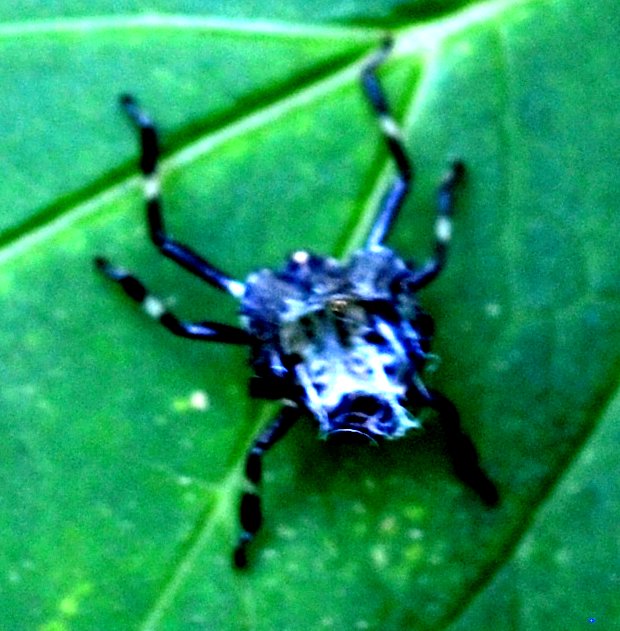
The bugs seem to be growing before our eyes. The third and fourth ones may actually have split into two colors (or it could have been all the shade on the browner one.) Guess what I think I found!

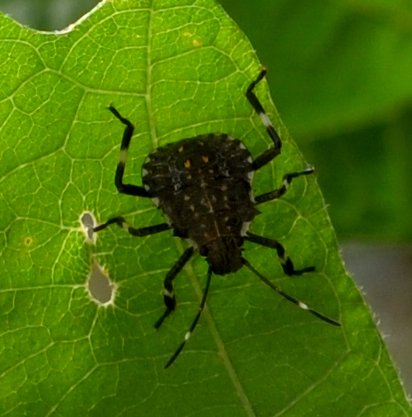
And still growing? This first image was from last week, the next two this week. I found in Flickr that one of the nymphs of the Brown Marmolated Stink Bug looks like the second bug in this row and the first one in the above row. What do you think?

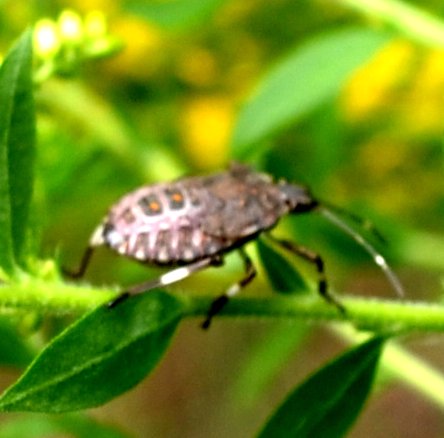
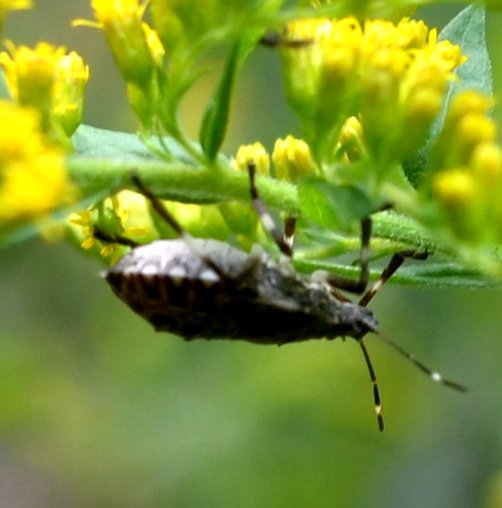
A browner version of the big one too?
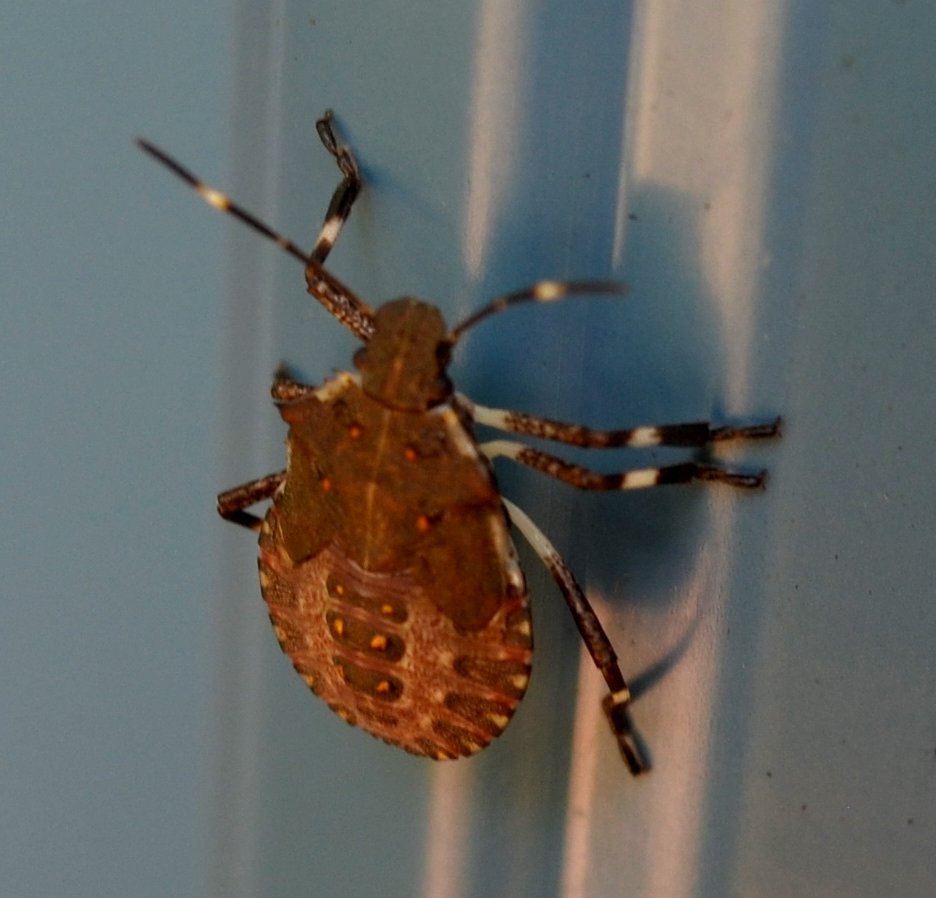
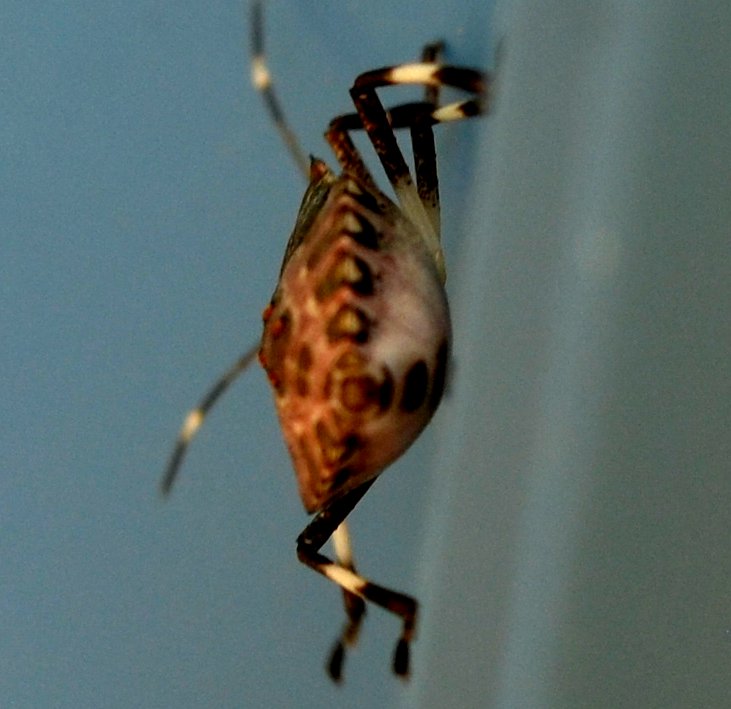
Last of the "bugs" for the week was a big surprise. Here are two poses of a cicada, who keeps the neighborhood full of happy trilling - probably the words are "hubba hubba baby, here I am!" Then a dragonfly, maybe the last of the juvenile Autumn Meadowhawks!

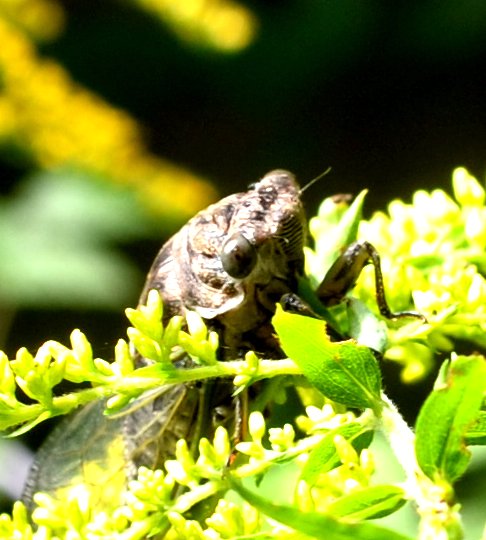

Now the going gets rough. I'm not so great at identifying bees, but suddenly I get a frontal shot of this baby. Look at those eyes and short antennae! It may be a color variation of Sparnopolius confusus.
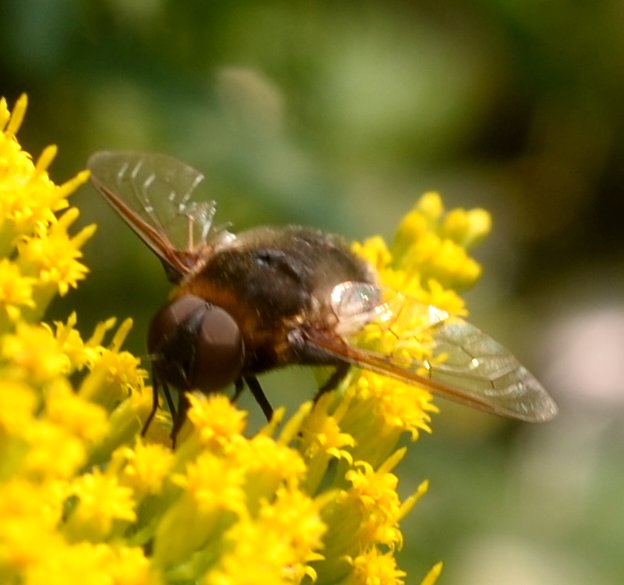
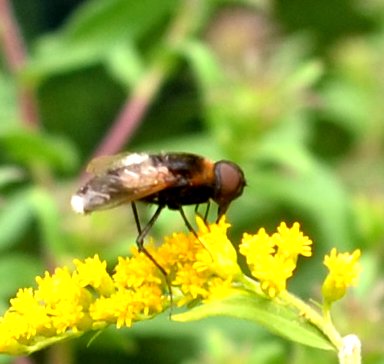 L
L
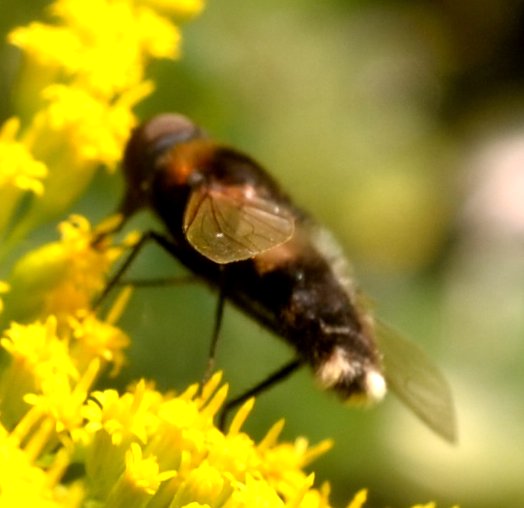
It may have been a largish hoverfly. Here's one. The next image may be of a fly I've been looking for, Loxocera cylindrica. Third is L. cylindrica as it appeared last year (August 27). This year, like last, we saw this fly in June, July and August.
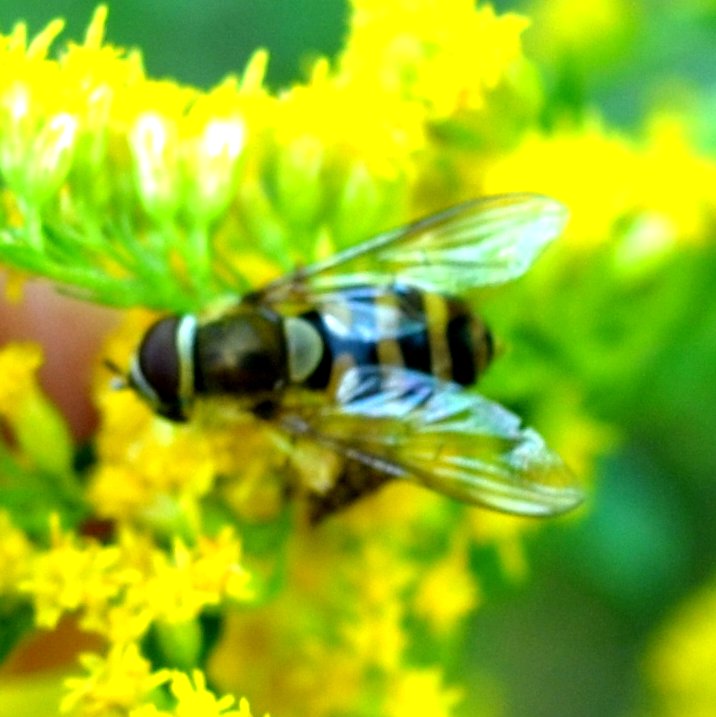
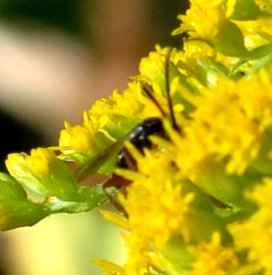
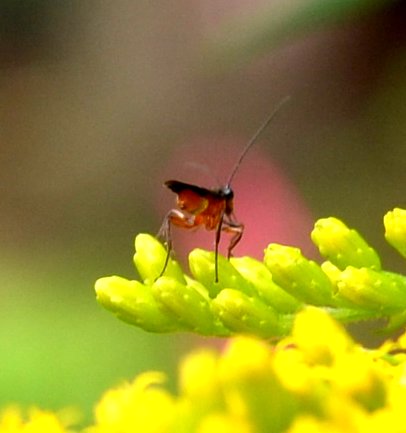
This is Minettia lupulina, a relative of fruit flies. Following it are one of the Aedes mosquitoes and a moth fly, which I must say is much more lovely out in the weeds instead of on the shop wall.
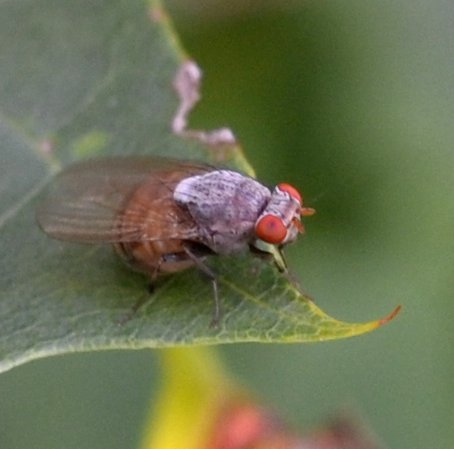

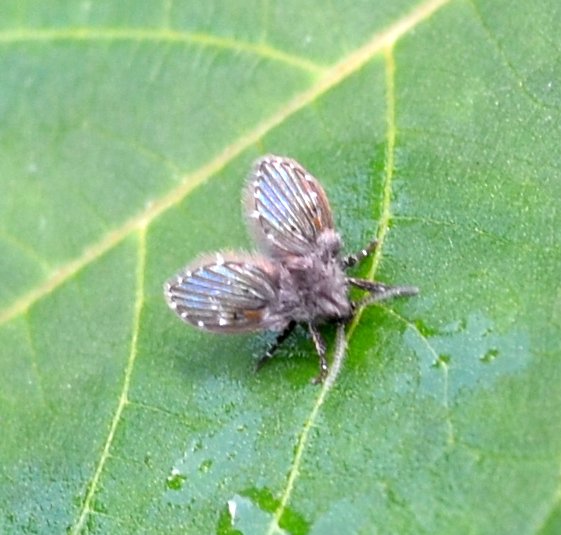
Some more flies. First is a mystery tiny fly, then possibly a Tachinid fly (judging from some of the spikes on its back), and finally a pair of small flies making whoopee in the bushes.
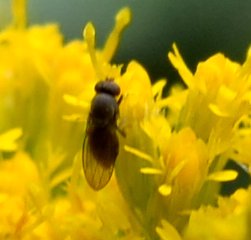
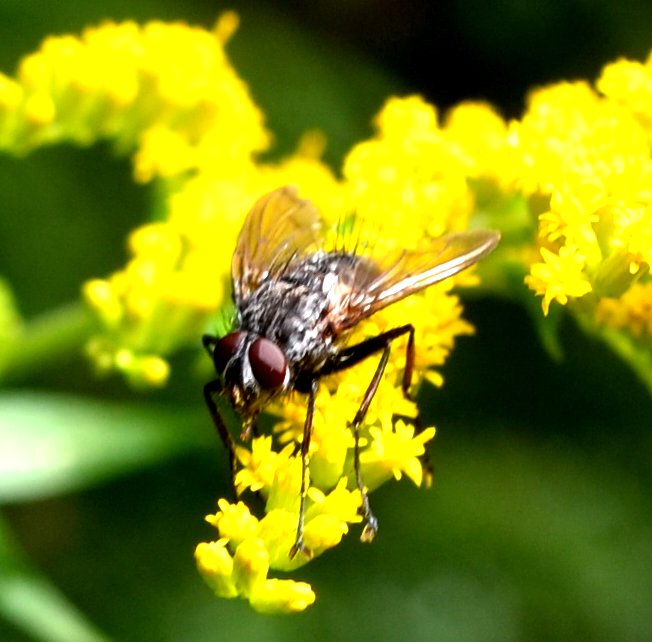
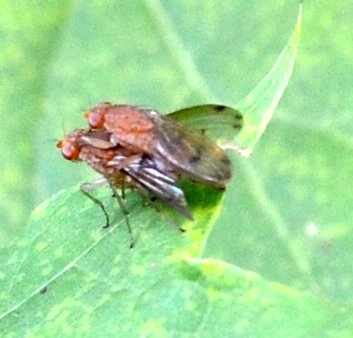 .
.
Can you believe we raced through the flies like that? Maybe I spent too much time looking for wasps and more exotic-looking creatures?
Froggy is still here though, on a lily pad. Here's a harvestman for you, and a mayfly (here in September).
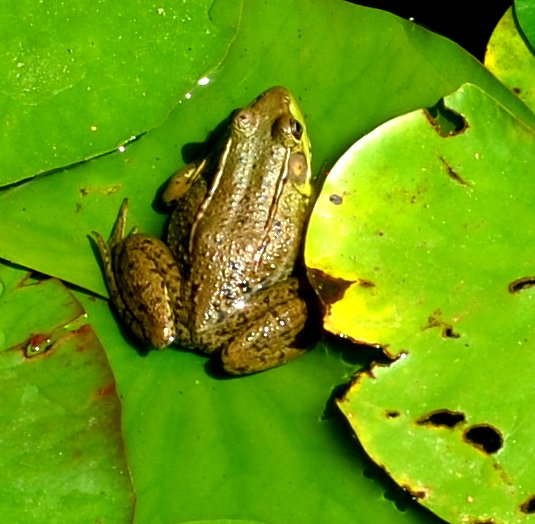
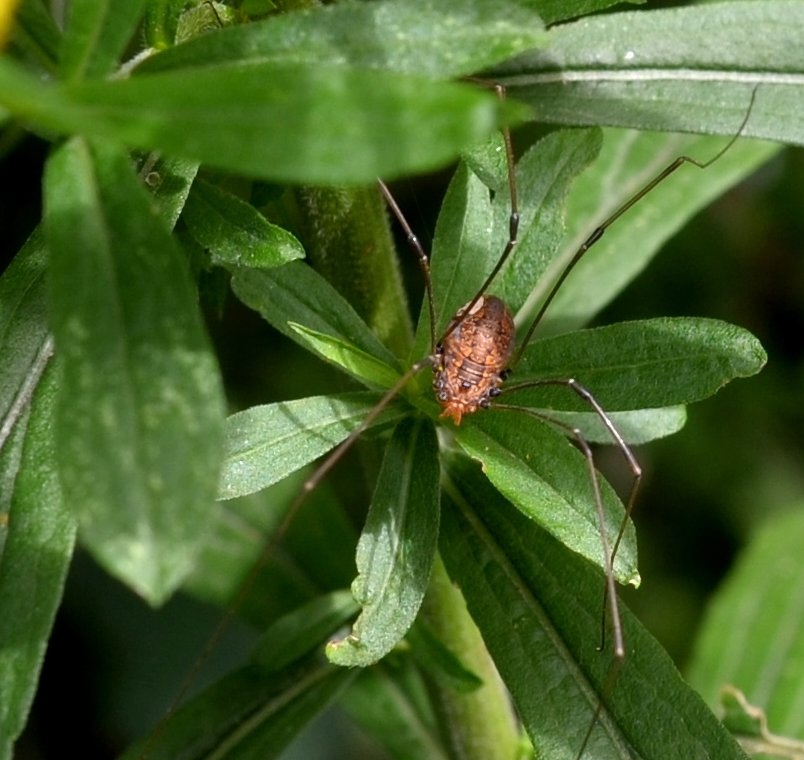
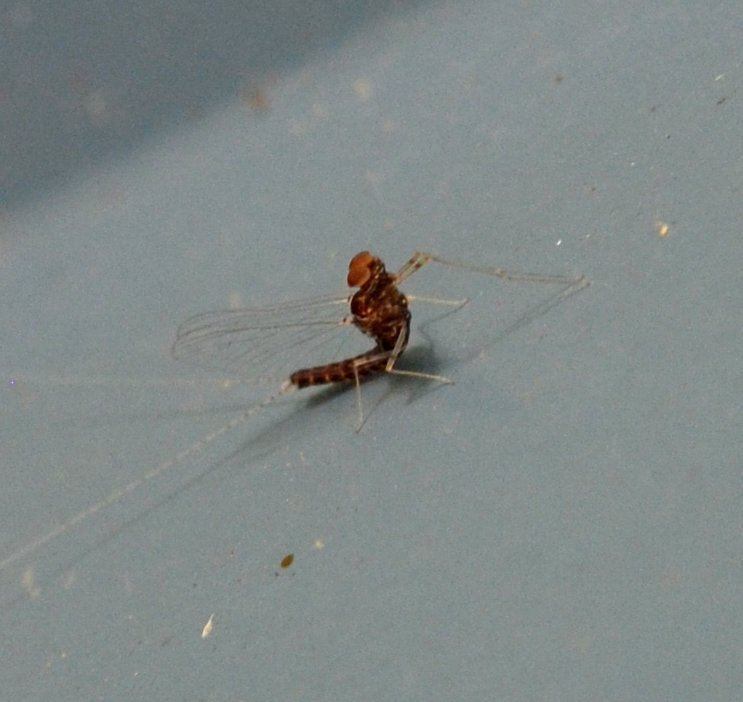
Meanwhile, our moths are perhaps more varied than usual. Here is an unknown one (to me, of course), then that most brilliant of smaller moths,the Ailanthus Webworm, and a seemingly ragged whitish moth.
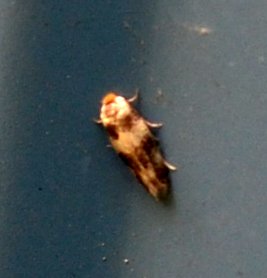
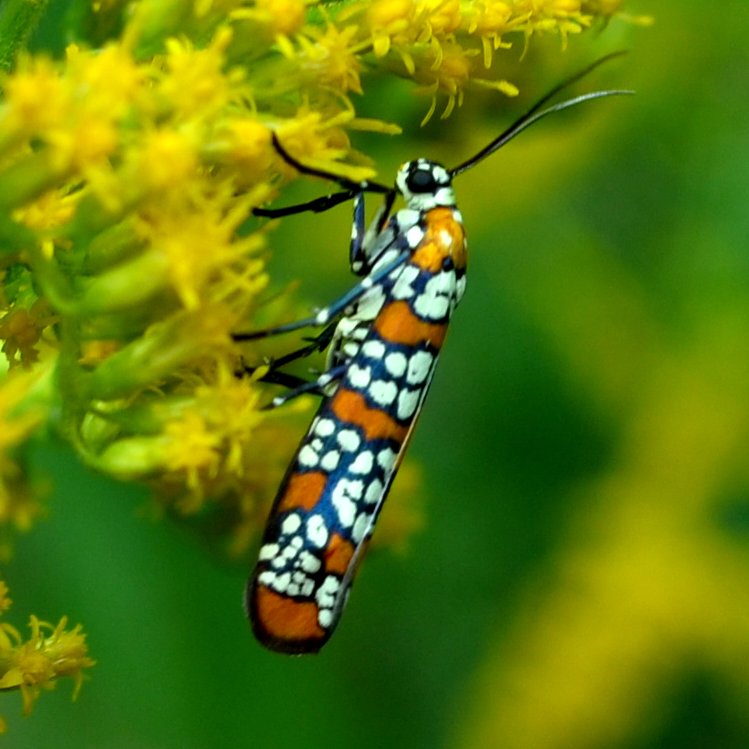
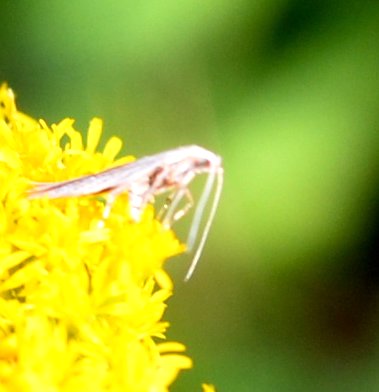
Could this be a sawfly of some sort? That's what I asked myself, and decided to submit it to Bugguide. Bob Biagi identified it for me as a female Myzinum maculatum. It turns out that this is a rather widespread wasp. So where has it been all my life? Back to the backyard - especially the goldenrod plantation. These creatures fell asleep and were still out of it when I visited them on the 8th. Top to bottom, the odd trio are a Locust Borer beetle, a female Northern Paper Wasp, and a Bumblebee of some size or other.
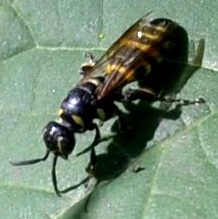
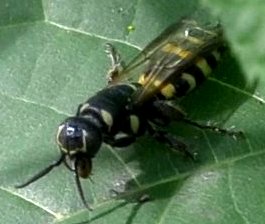
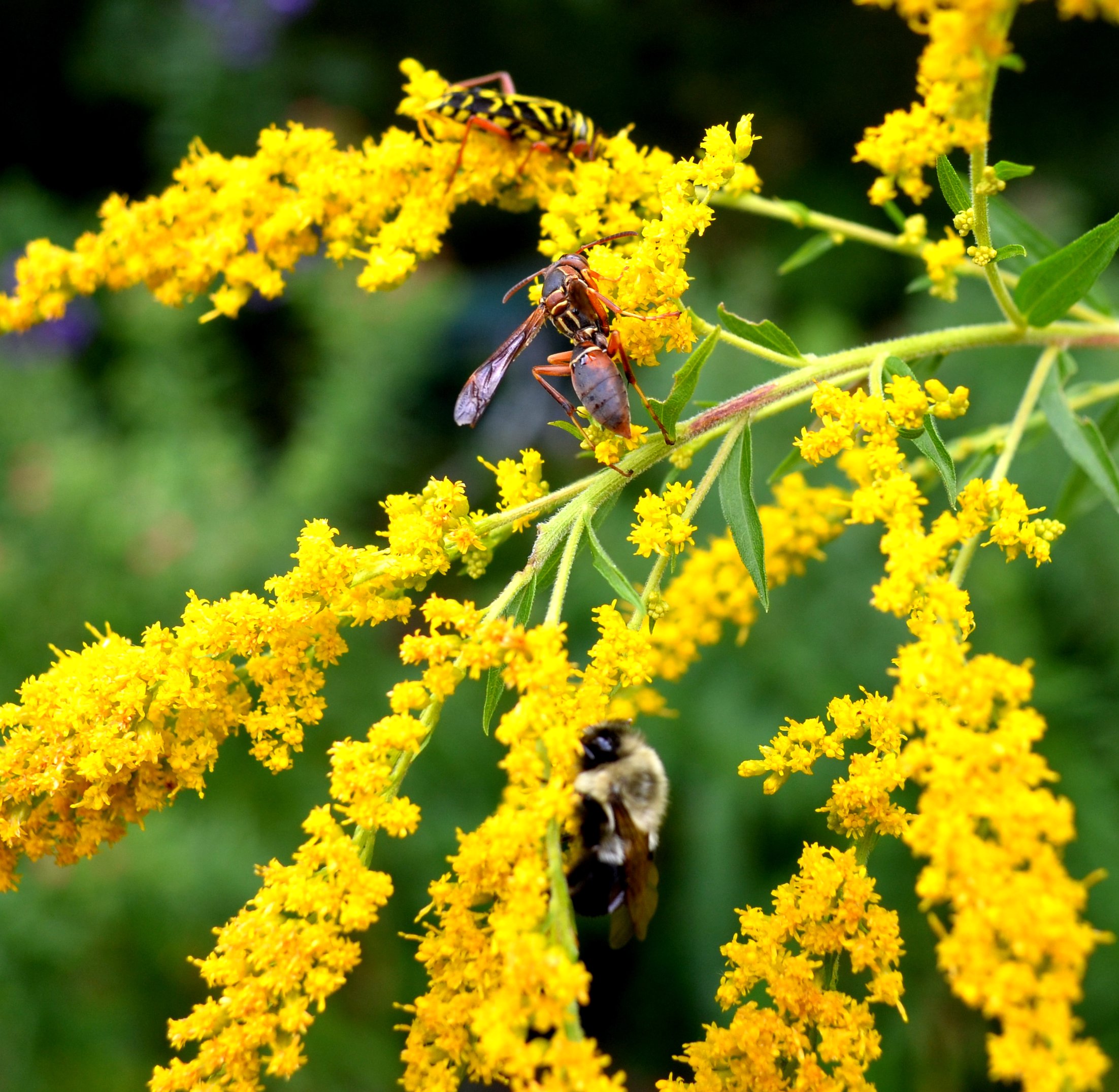
The scorpionflies that can curl up their tails are supposed to be males. The second picture shows one with unfurled tail, but I happen to have seen it unfurl it. It's still a male then. Haven't seen one of these beautiful little snails for a while (maybe last year!).

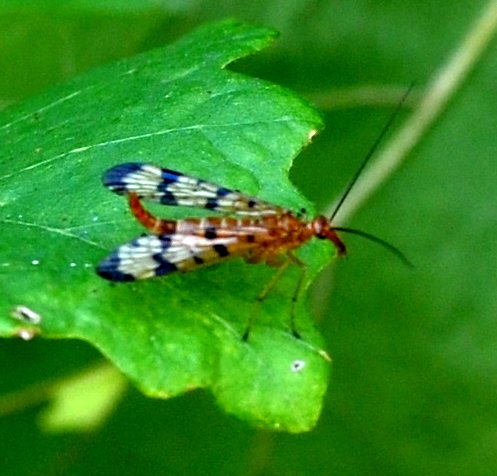
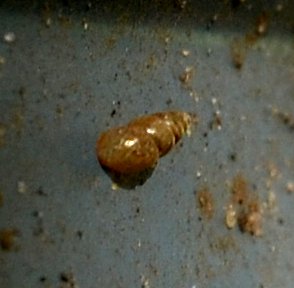
Here's a Common House Spider after laying that huge egg case. In fact, the egg case is the size the little mother was before laying the eggs. Here's a yellow crab spider preparing its supper. And here's a sac spider. Keep your fingers off it. Finally, a small yellow spider trussing up an unusual cut of beetle (??).
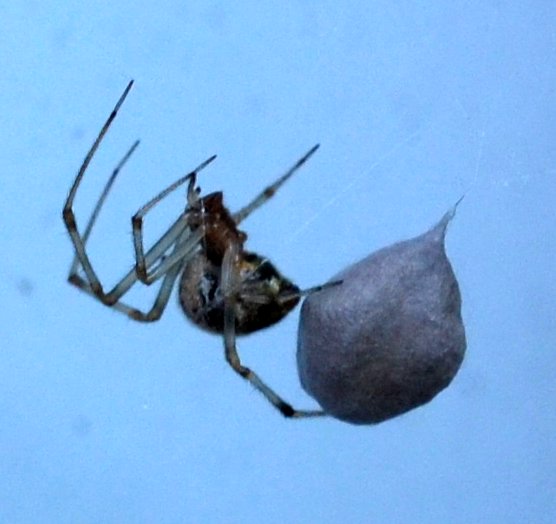
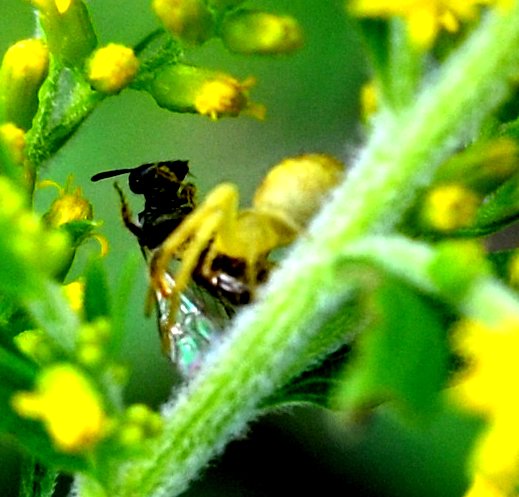
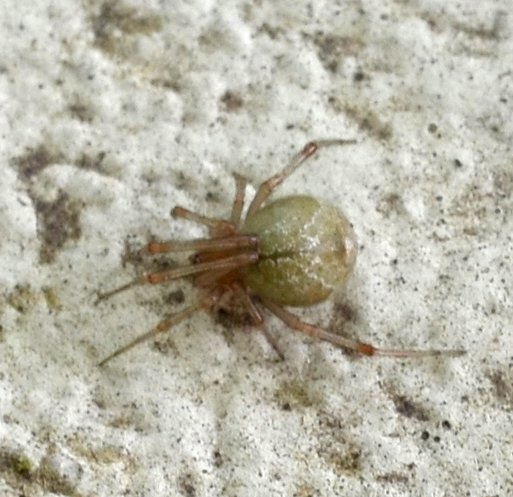
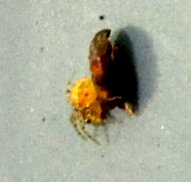
Some sceneries! (Remember the shrubberies?) First, a magnificent shadow picture -the early morning sunshine coming through the branches of the blue spruce. A reminder that the trumpetvine had an extremely long flowering period this year. The Mandeville plant with its bright red blooms has been happy on the deck for a few months now. And finally! The purple asters in the front yard are opening up.
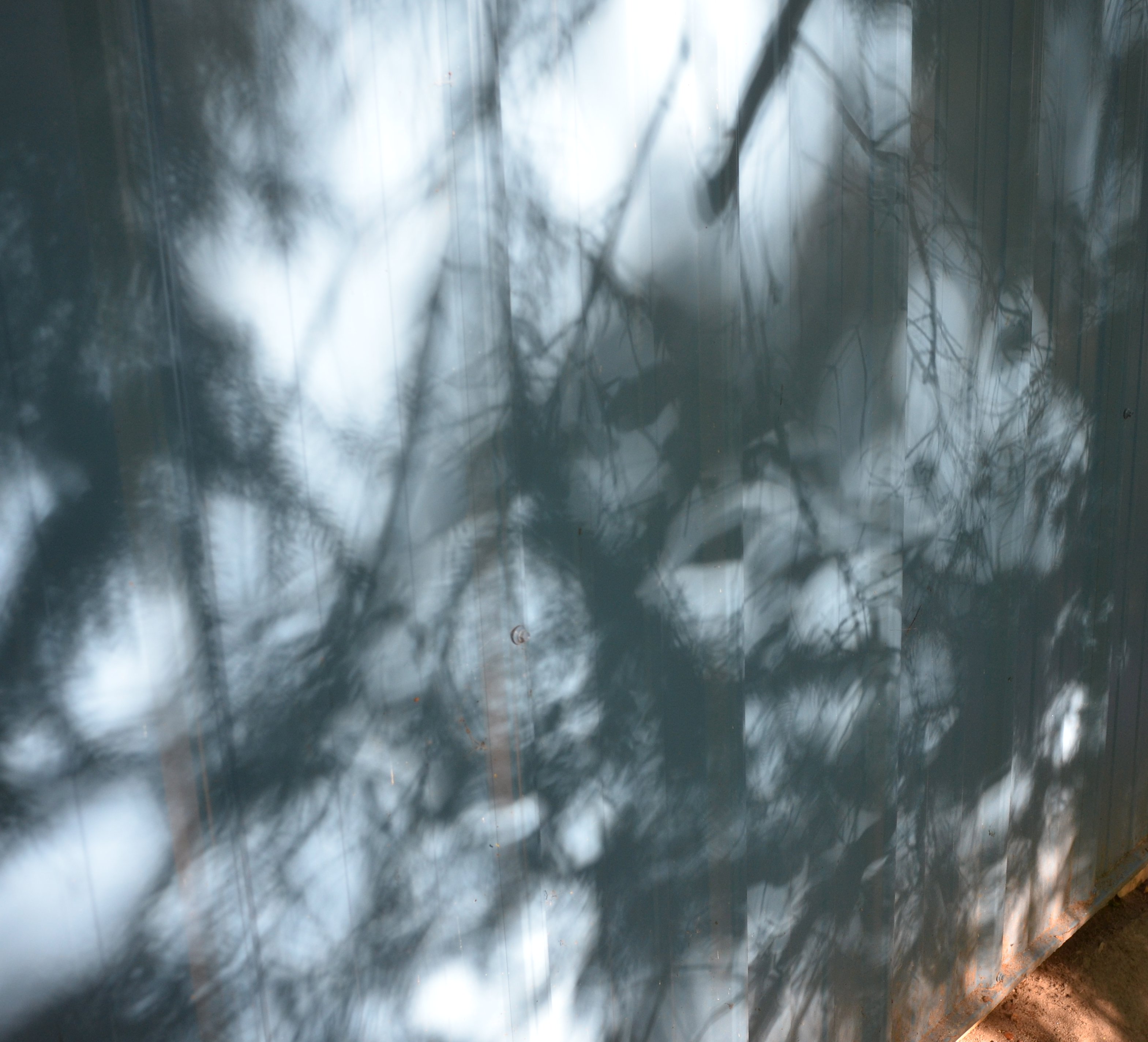

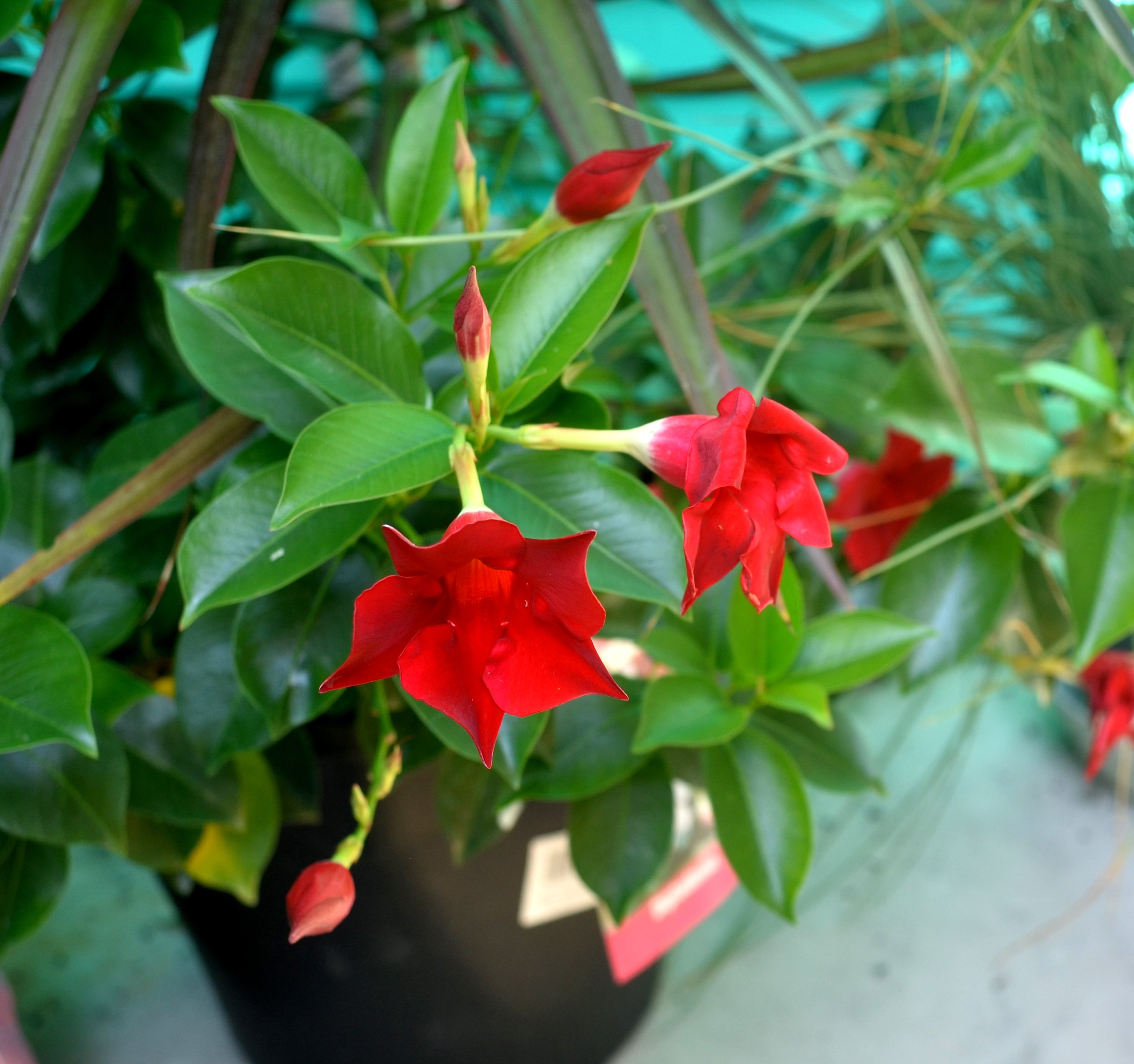
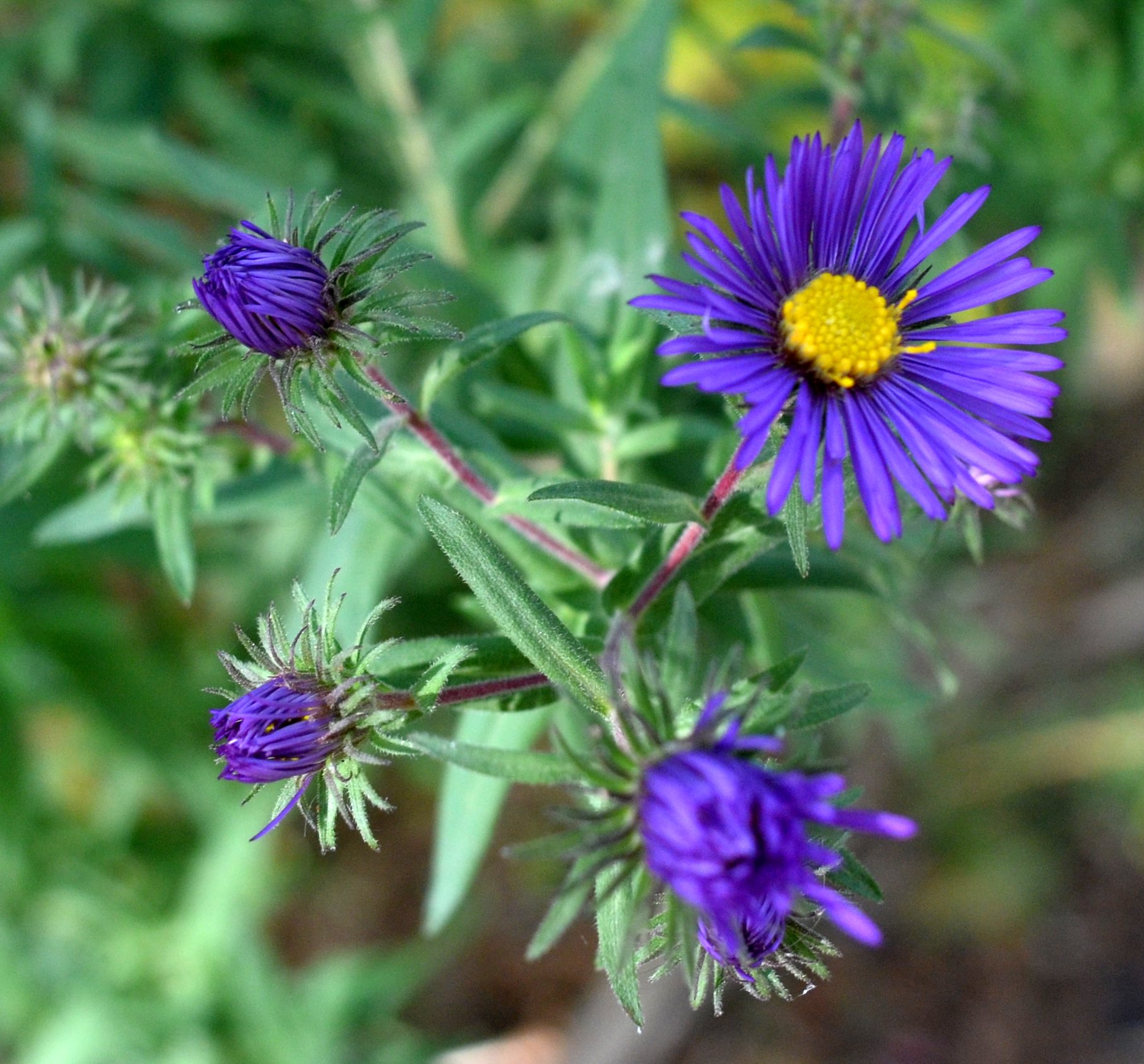
Now to the wasps. I have spent a lot of time comparing my photos with those of others, most importantly M.Buck et al, for their book on many of the major groups of yellowjackets (hornets), paper wasps, and potter wasps, who lay their eggs in little clay pots. But I don't always get it right - so consider those sources. Here is Ancistrocerus adiabatus, a female potter wasp, and Ancistrocerus campestris male.
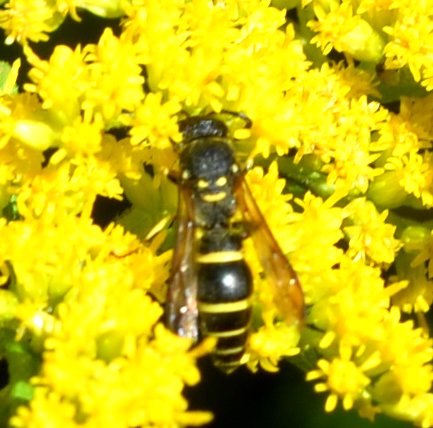
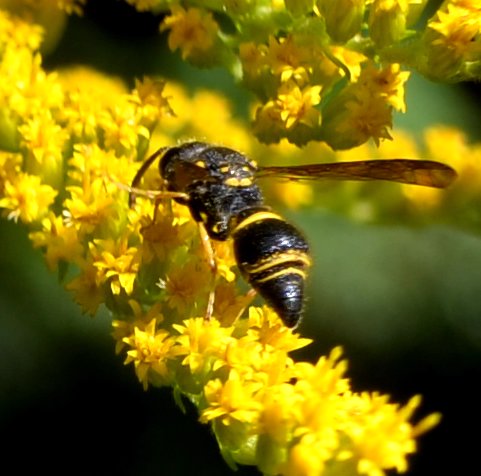
These are Eumenes fraternus, another potter, female and male (2 views of the male - the face in the second is a male's face and it was taken with the former, so they're most likely the same individual.)
.jpg)
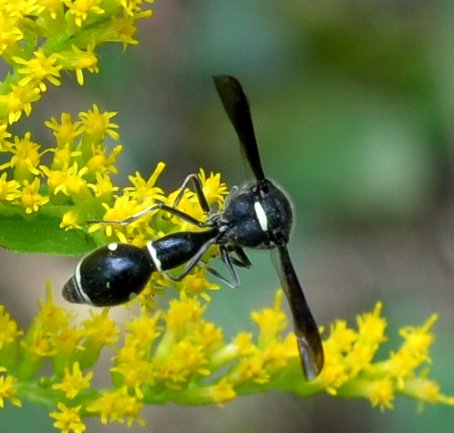
.jpg)
Here is Cerceris clypeata, also called a weevil wasp, since they (or their larvae) live on beetles and especially weevils. The two pictures were taken at 3:29 p.m. on the 5th, so they are most most likely the same individual, and by the face in the latter, it is a female. Similary, the last two pictures were taken the same minute of the 6th.
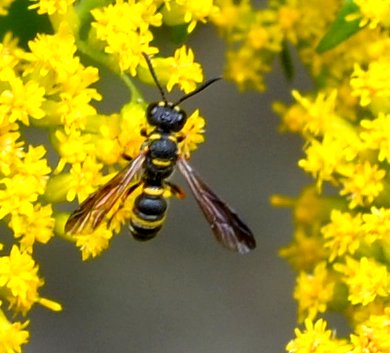
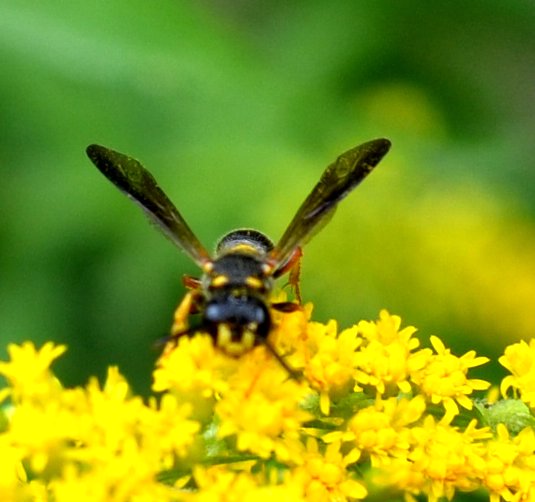
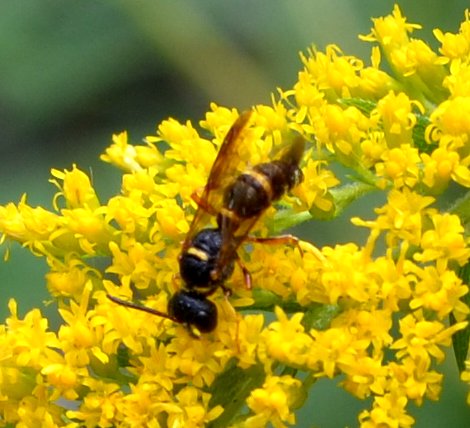
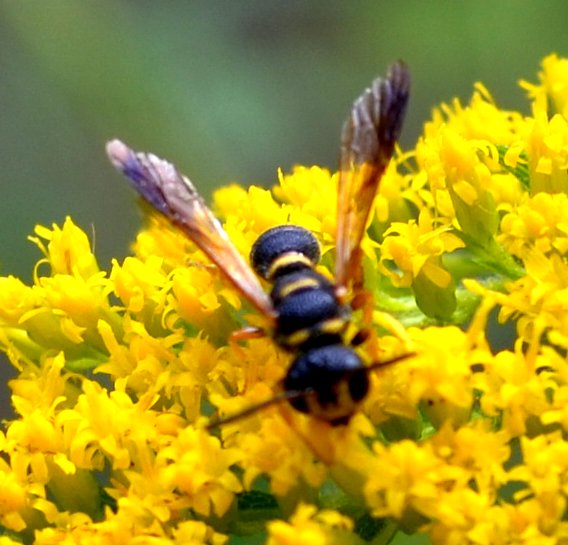
We discussed the Bee Wolf (Philanthus gibbosus) last week. It was the first little wasp to appear this year. I understand that the males are about twice as long as females. Most all the Bee Wolves I've ever seen have been famales. Here's a female face.
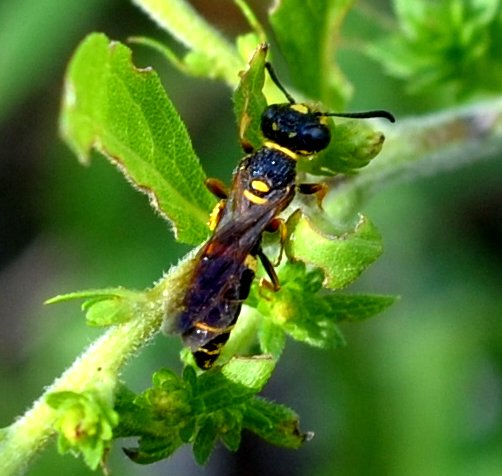
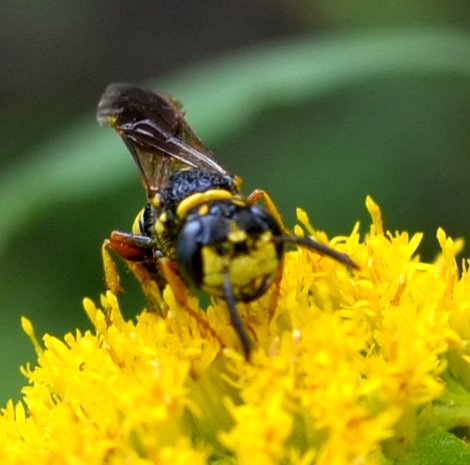
Meanwhile, here's a male face from Bugguide.
Here's another little waspie- it's called Ectemnius maculosus. It's recognizable because its little yellow bands are broken at the top and bottom, so you only see the bits on the sides of the abdomen. I don't know them well enough to tell you which is female and which is male. The next two images are of the face and body of a male aerial yellowjacket, Dolichovespula arenaria. Haven't seen a female yet this year.
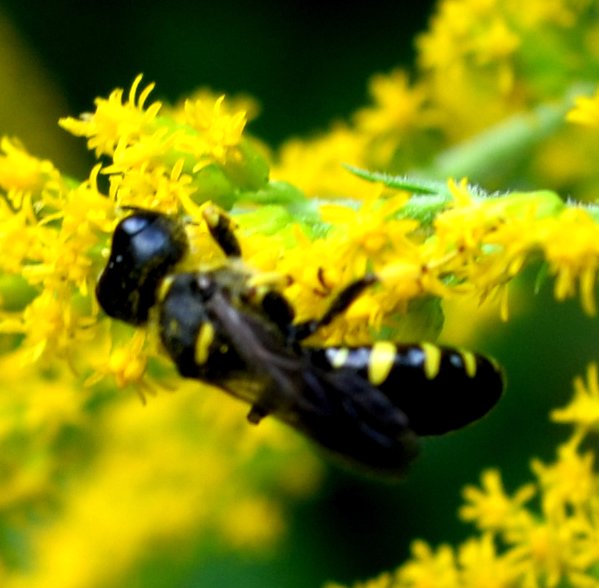
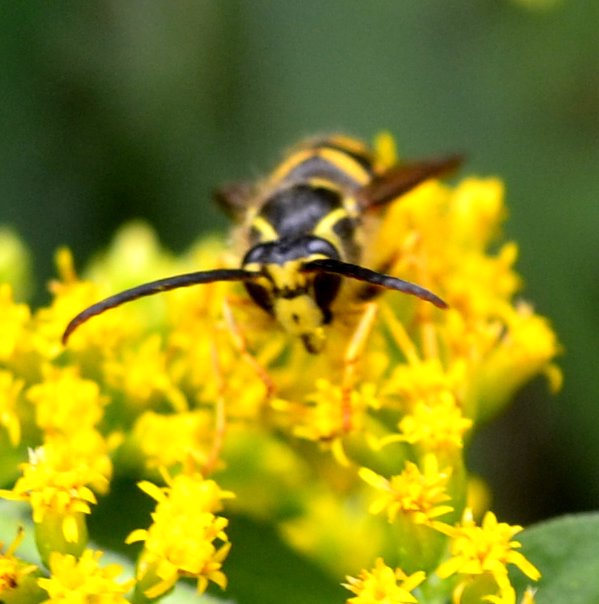

Here is one of my favorite wasps. This is a female Northern Paper Wasp. These two pictures were both taken at 3:16 p.m. on the 4th. She does not have the shield-shaped face ornament of a male, for instance in this third picture.
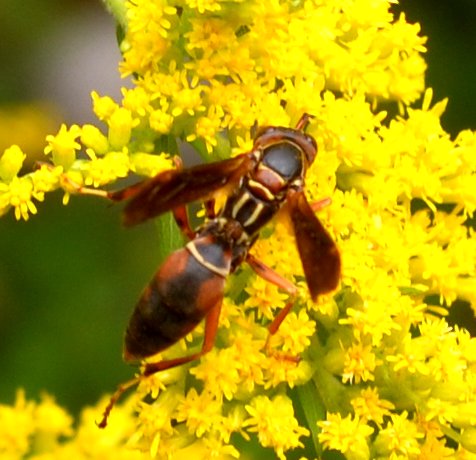
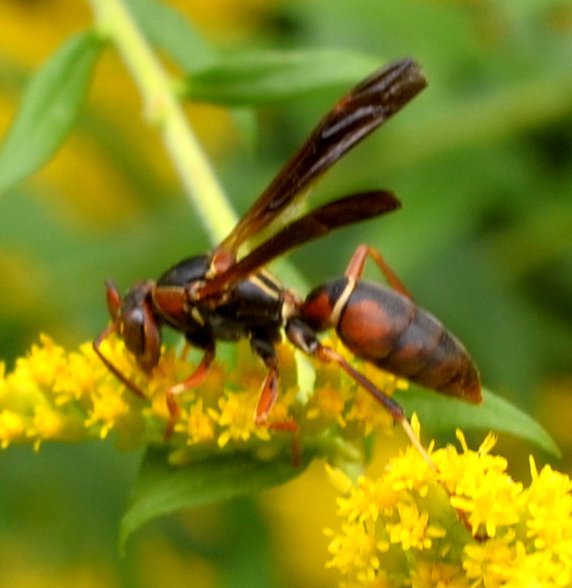
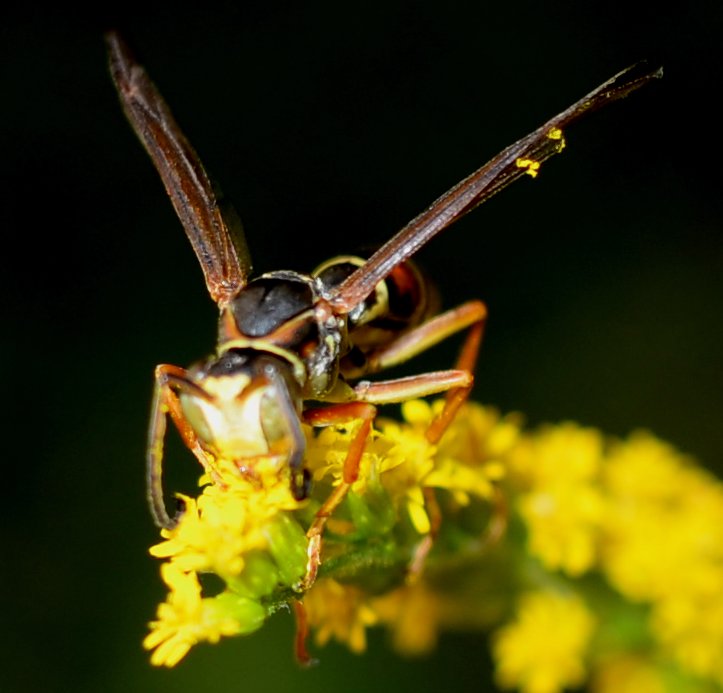
There were a lot of kinds of thread-waisted wasps. I wasn't able yet to differentiate them, but I'll work on that some day. Just not today. Oh! I almost forgot that my friend Kathleen took pictures of her praying mantids. Lucky her! And lucky for this couple. Note that the female is already a lot fatter than the male. Now she looks radiant.
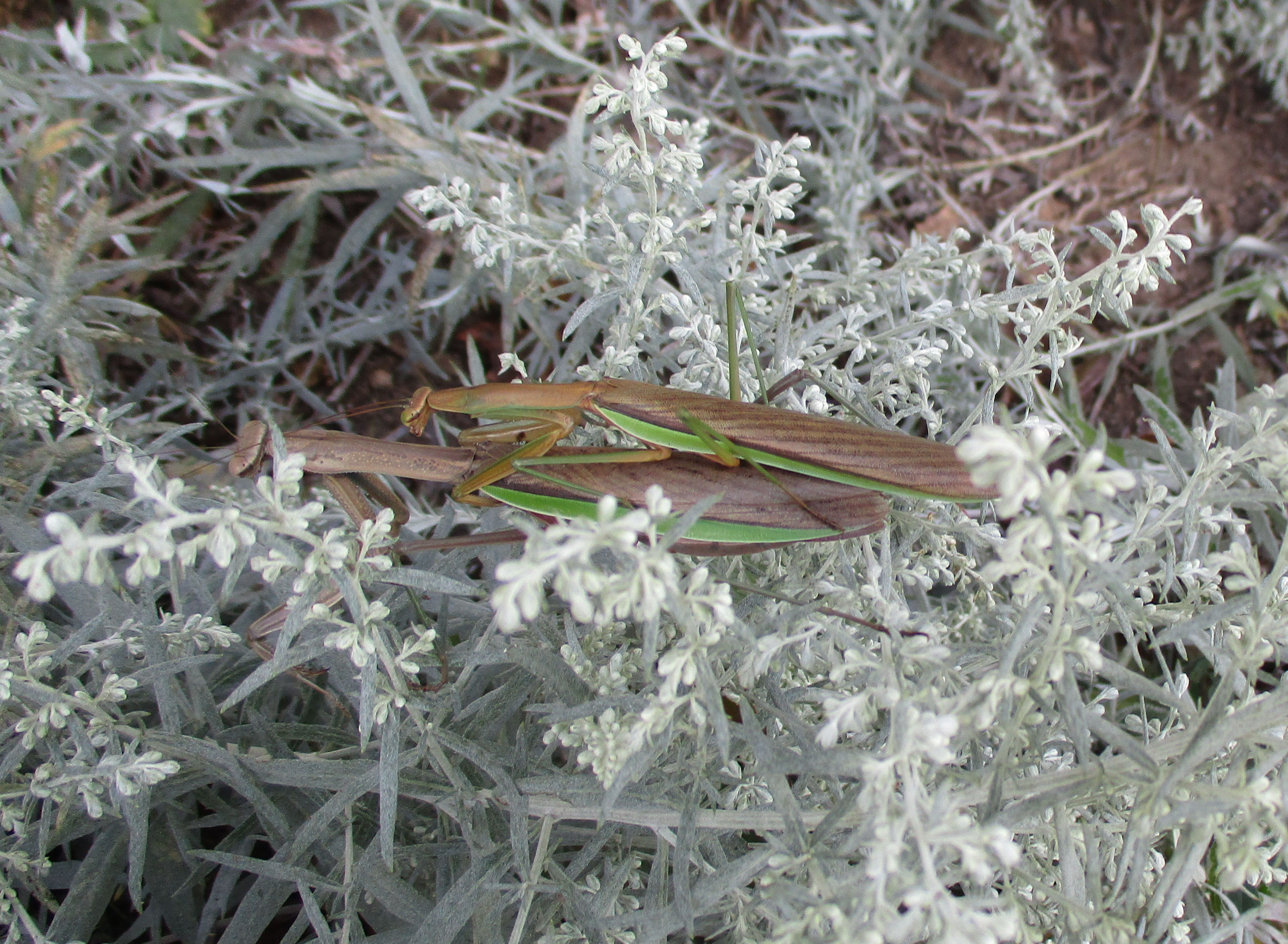
.jpg)
Thanks once more for visiting. See you next week! Oh! Let me tell you the sad story of my camera's battery charger. I had it plugged in in the kitchen so I could dash in the back door to change batteries when needed. Yesterday I noticed the charger was strobing when it should have had the steady "ready" light on. I drove to Jackson to try to get another charger. Fortunately I didn't bring any money. Now I had two discharged batteries. In the evening I got out an older camera and realized how much better the new one was. I brought the charger upstairs where I could monitor it. After about two hours I took the battery out and into the camera, which said it was fully charged. I figured that I had gotten it out before the charger turned on it and discharged it. So I put the other one in and about two hours later it had the steady light. The camera said it
was fully charged too. So now the hypo is that the kitchen outlet is sicko or the charger is depending on being monitored. Well, I'm not going to use it again. Maybe it needs fixing. Did any of you ever hear about such a thing? Anyway, it's 5 on Sunday, and so I'm wrapping this thing up. Have a wonderful new season!
Love, Martha
Back to September 3, 2017
Forward to September 17, 2017
Back to 2017 menu
Back to main menu
copyright Martha O'Kennon 2017



























































 L
L
































.jpg)

.jpg)













.jpg)